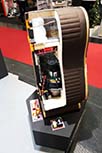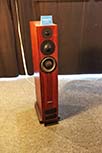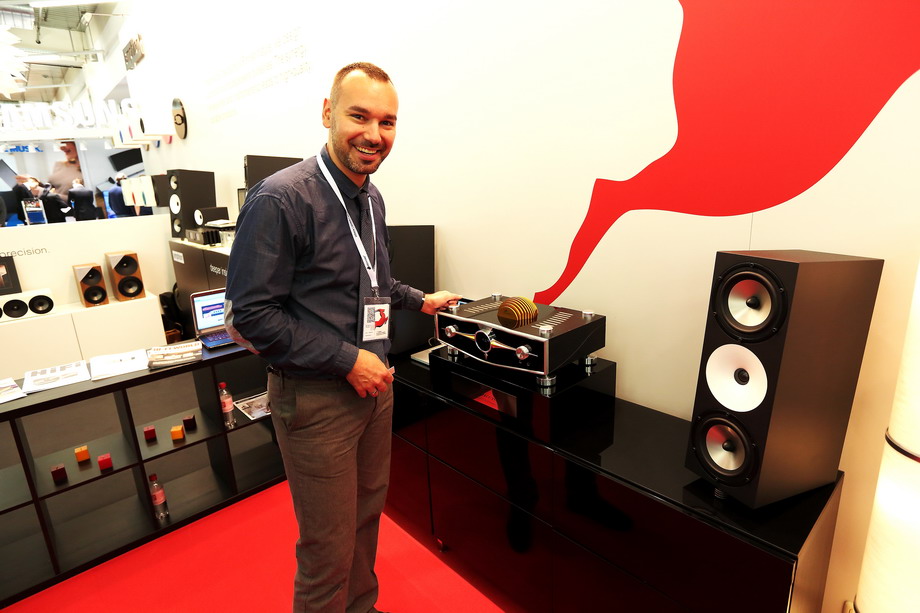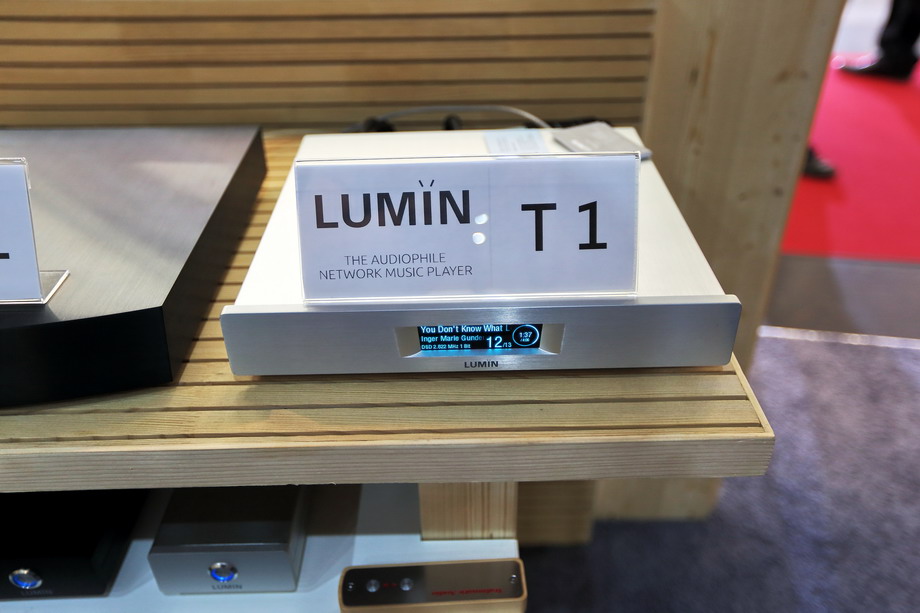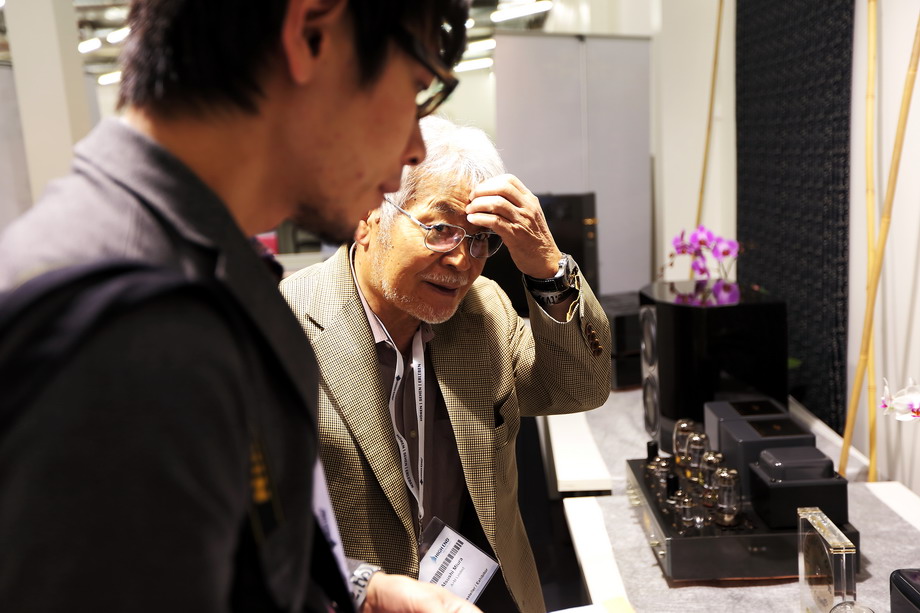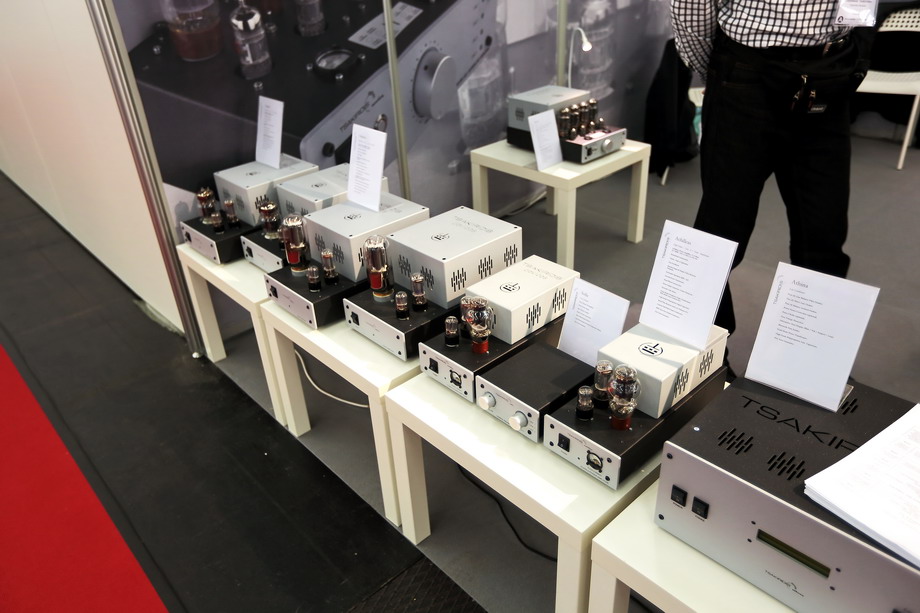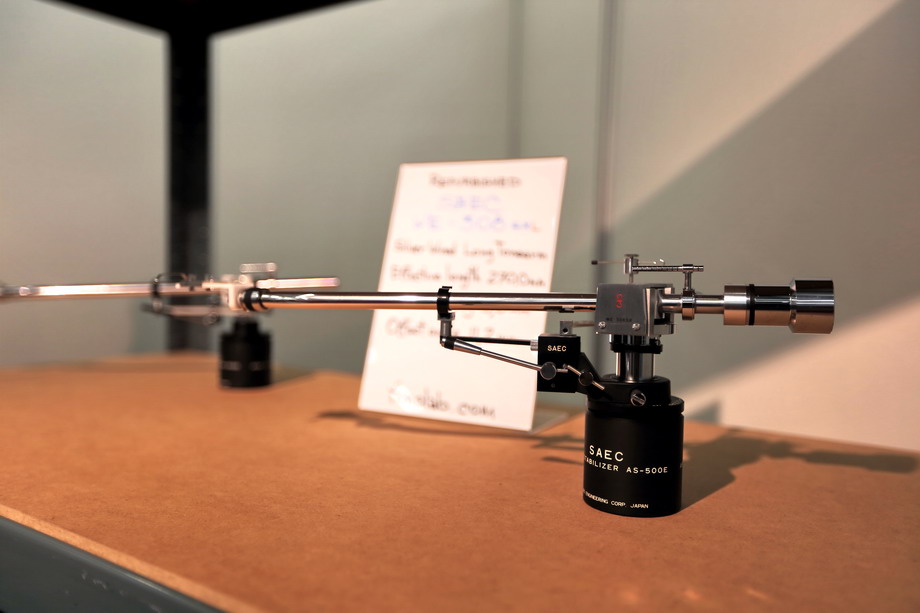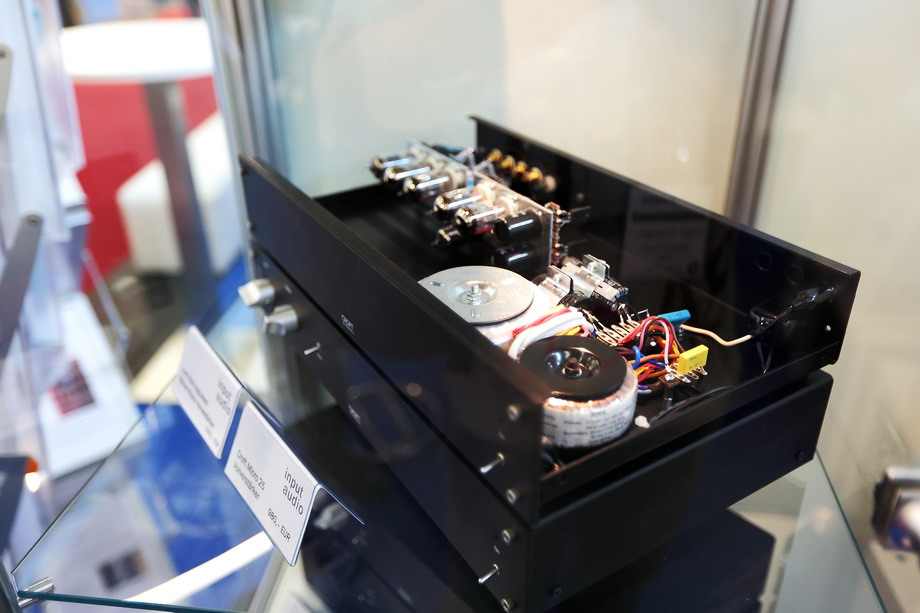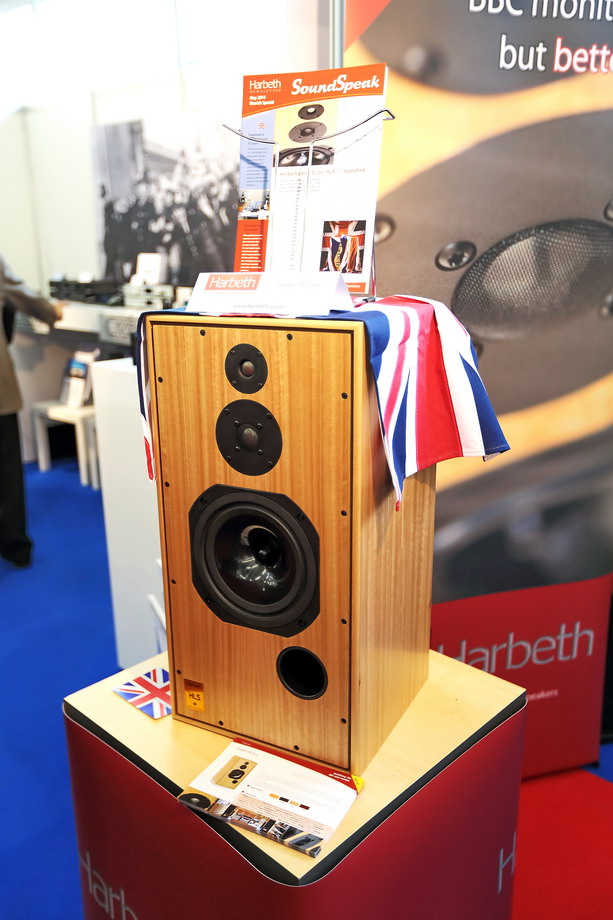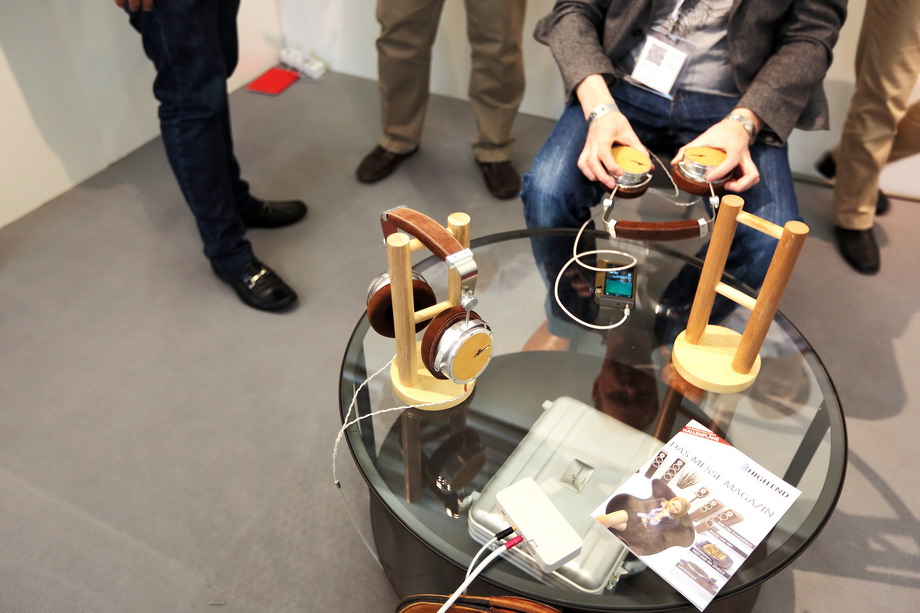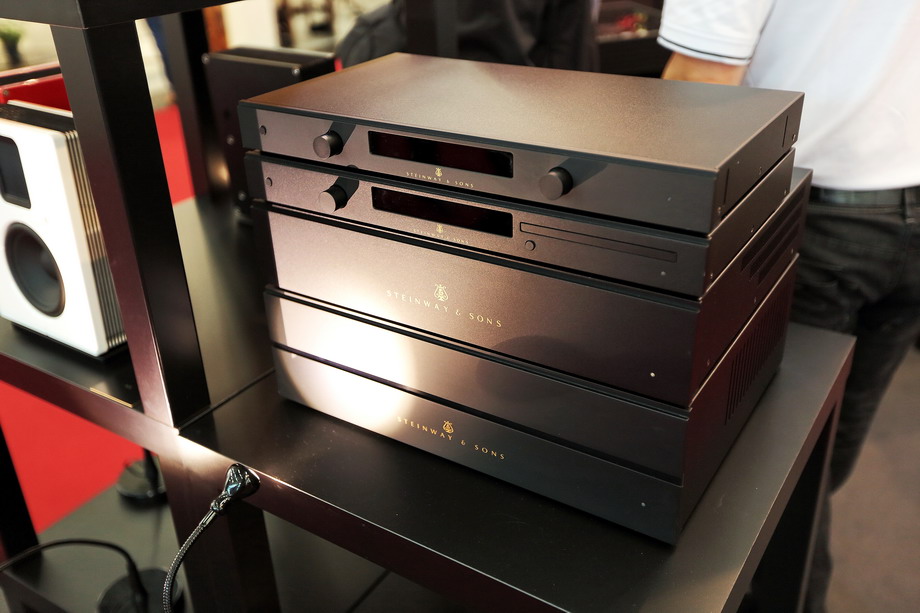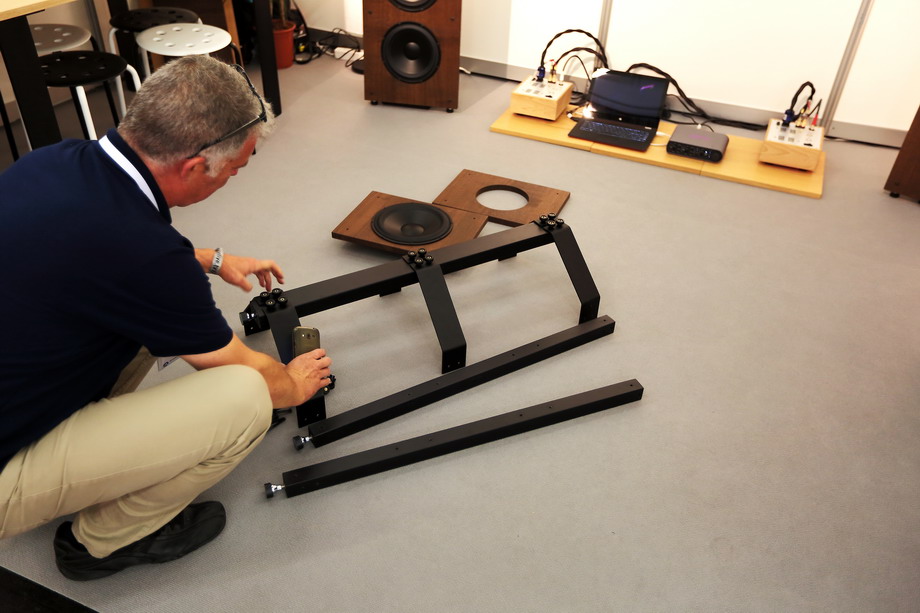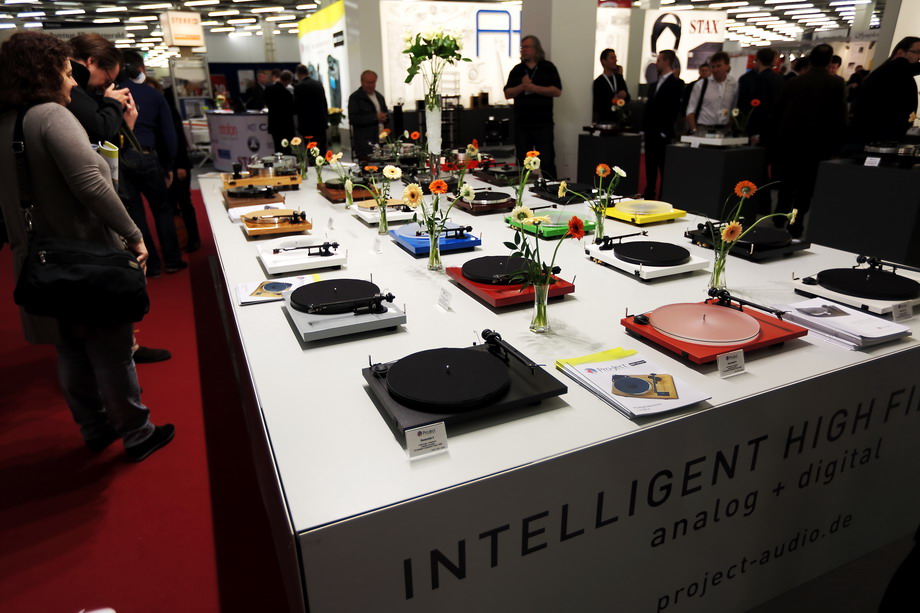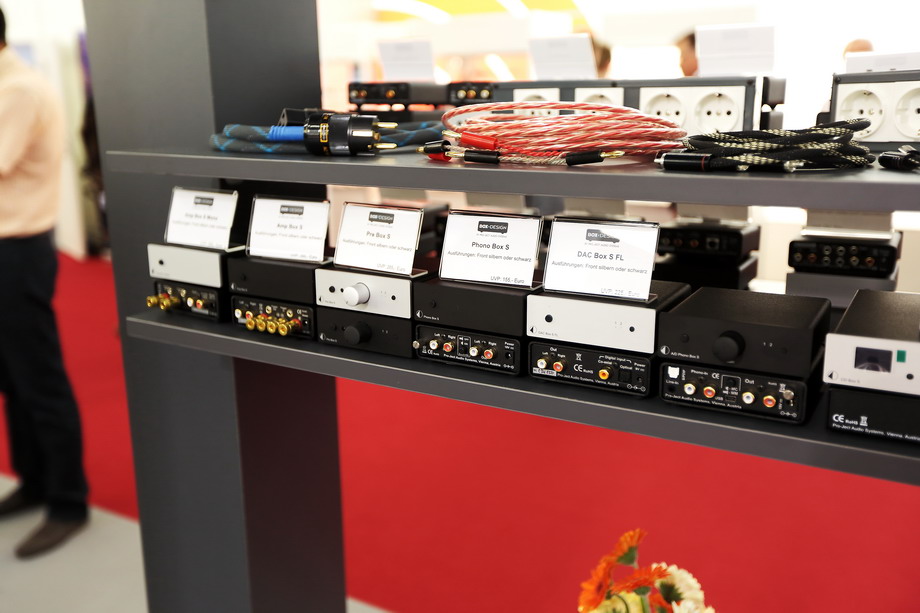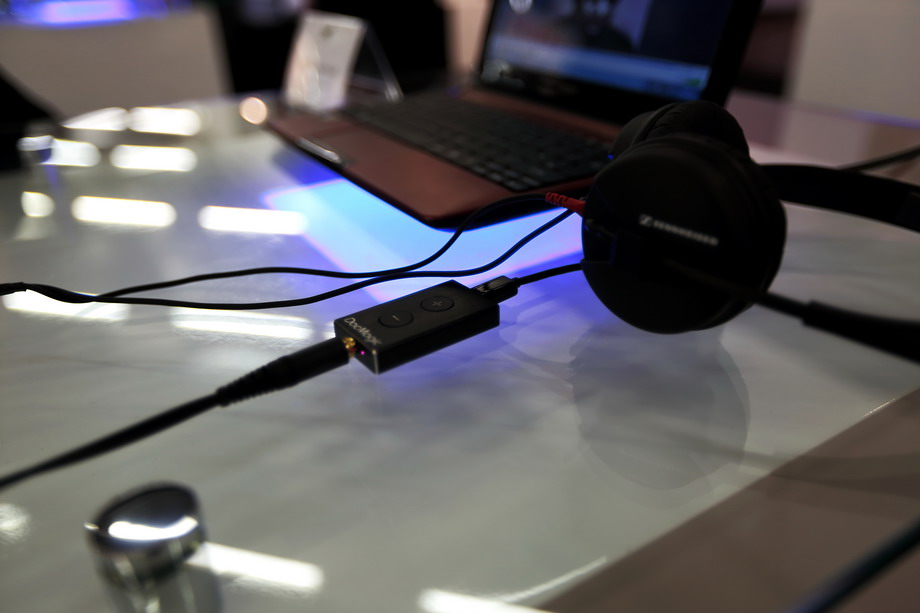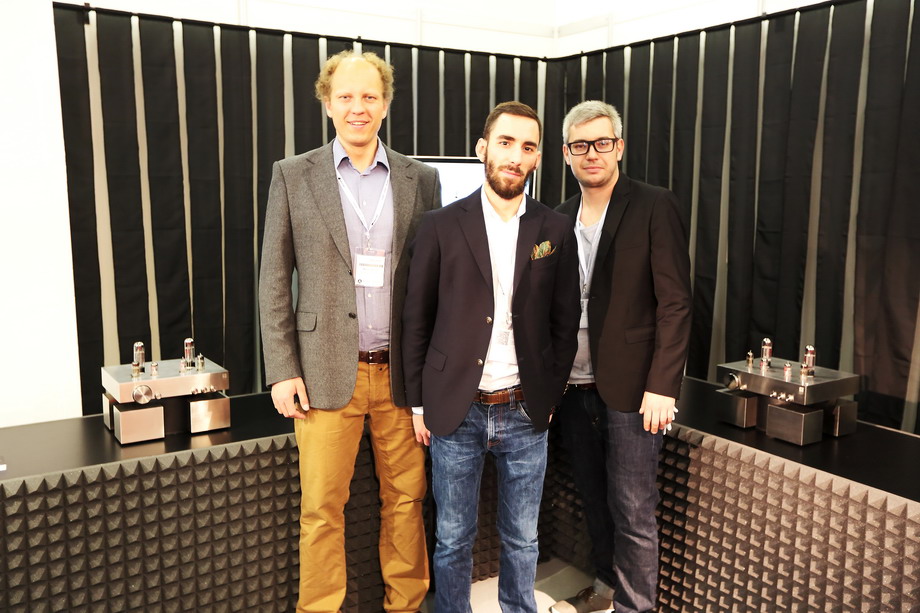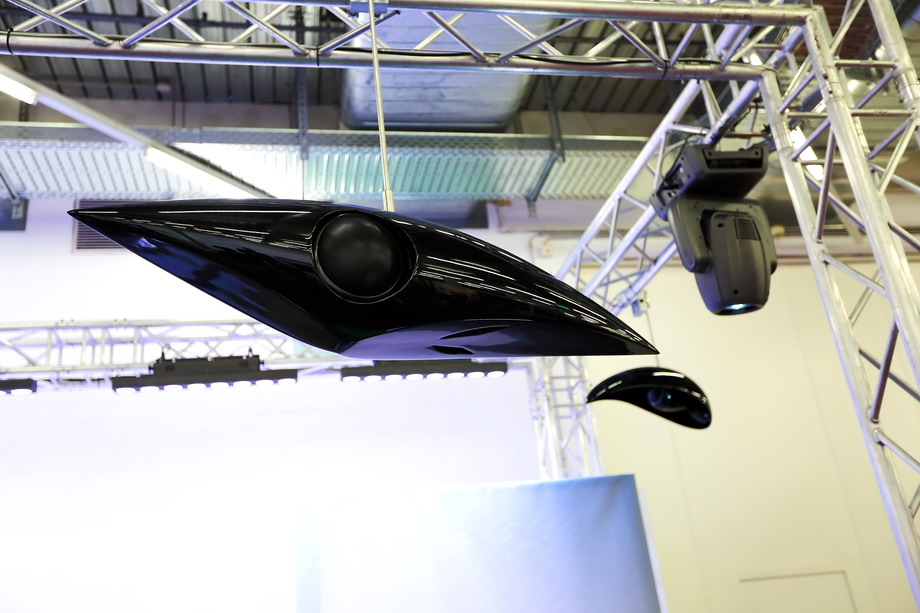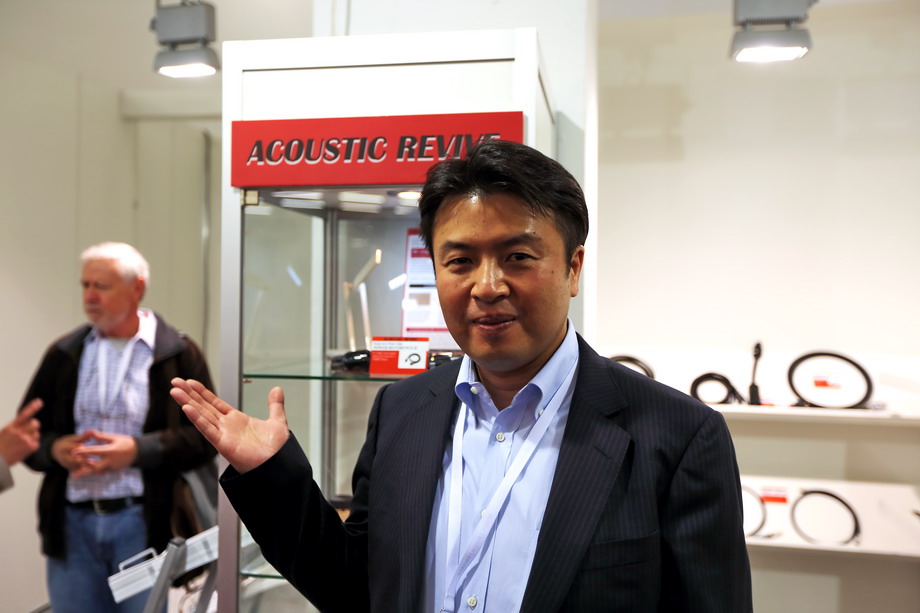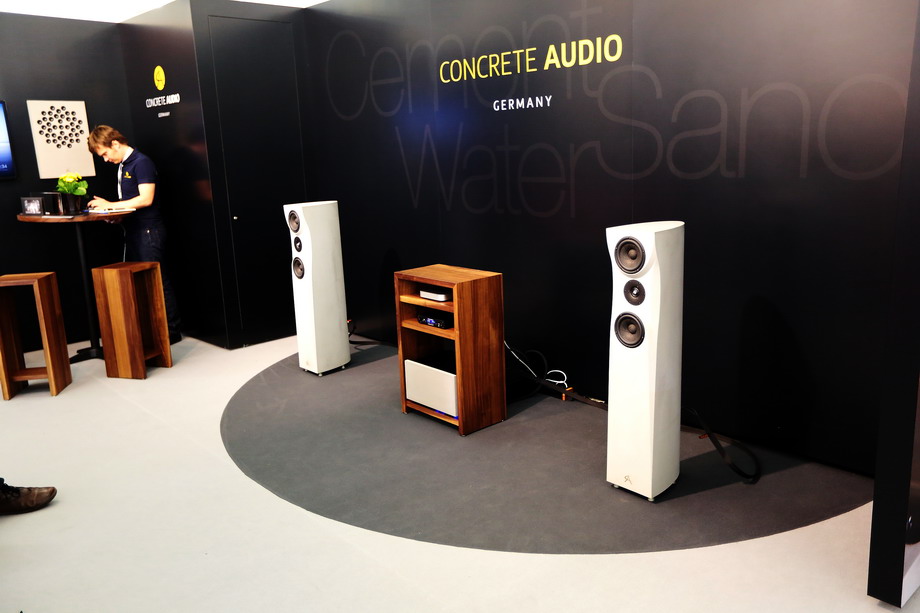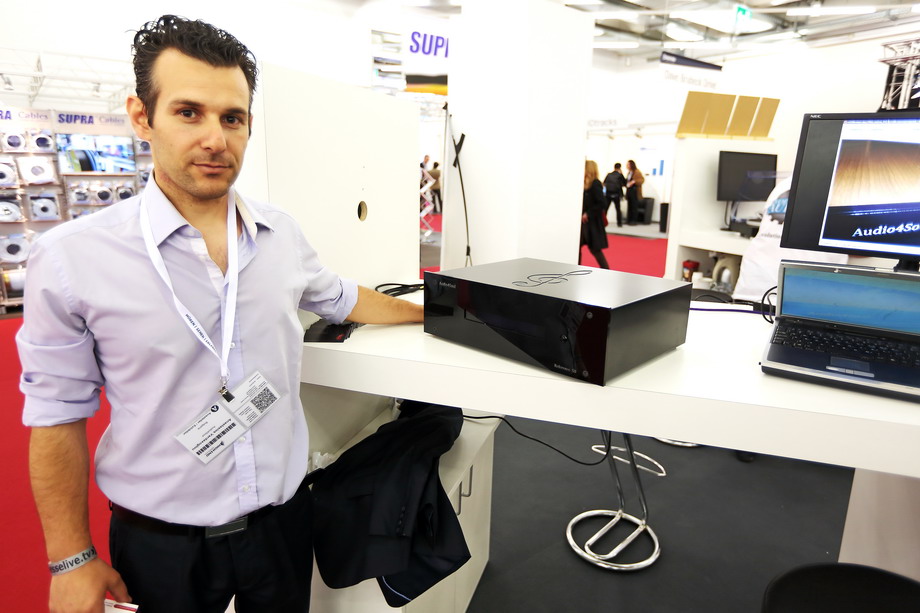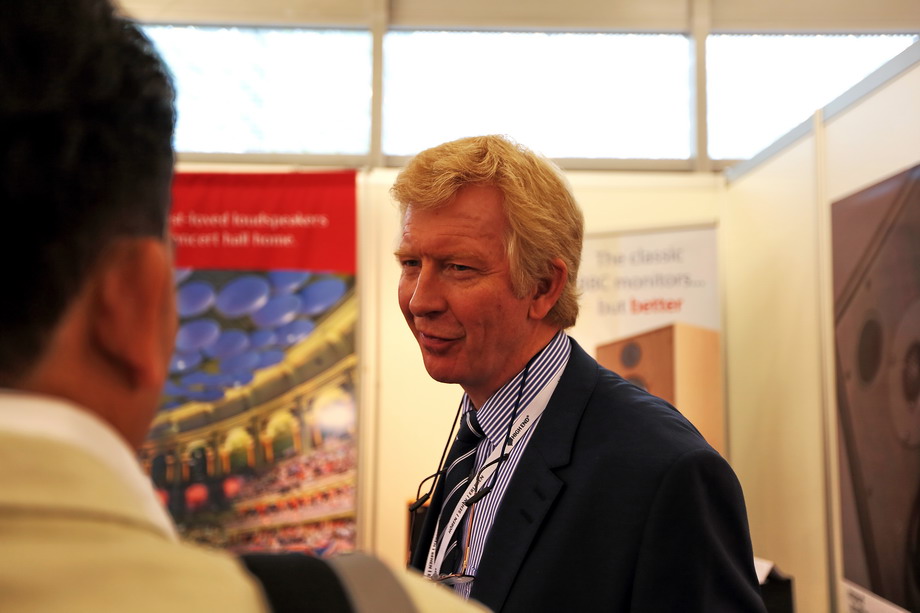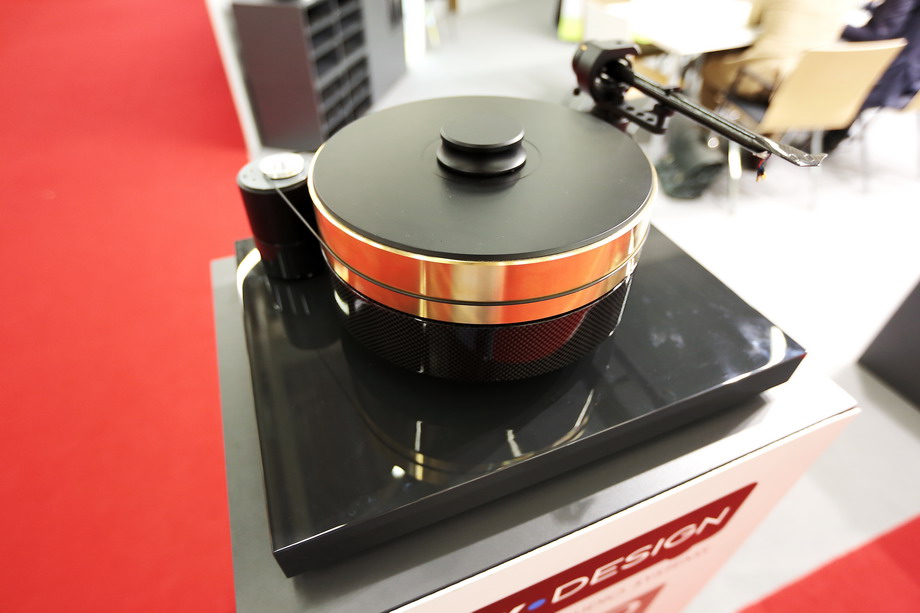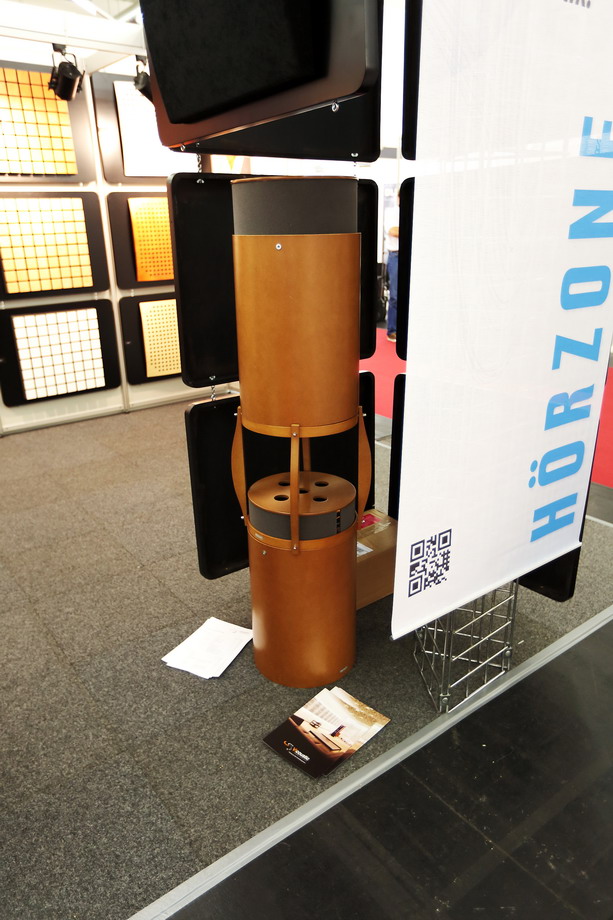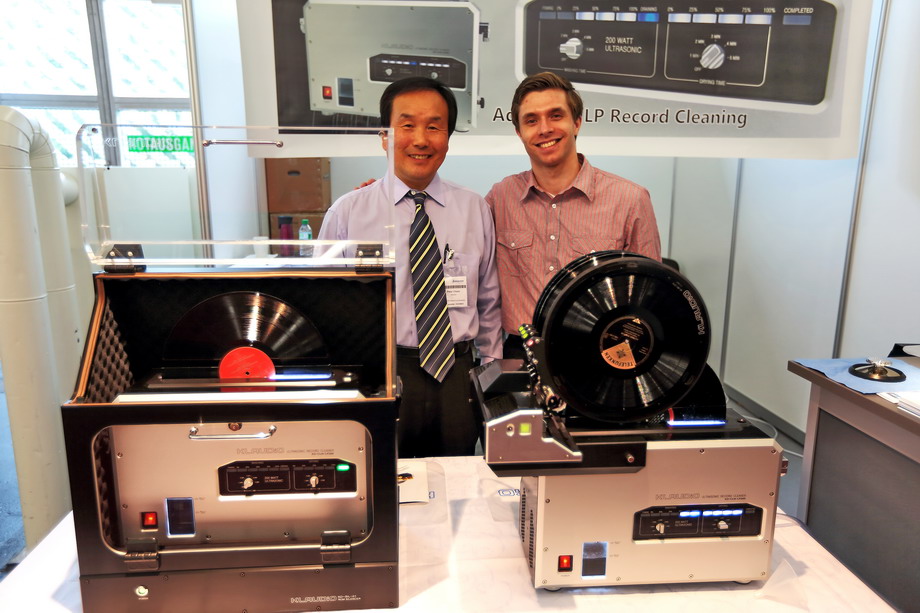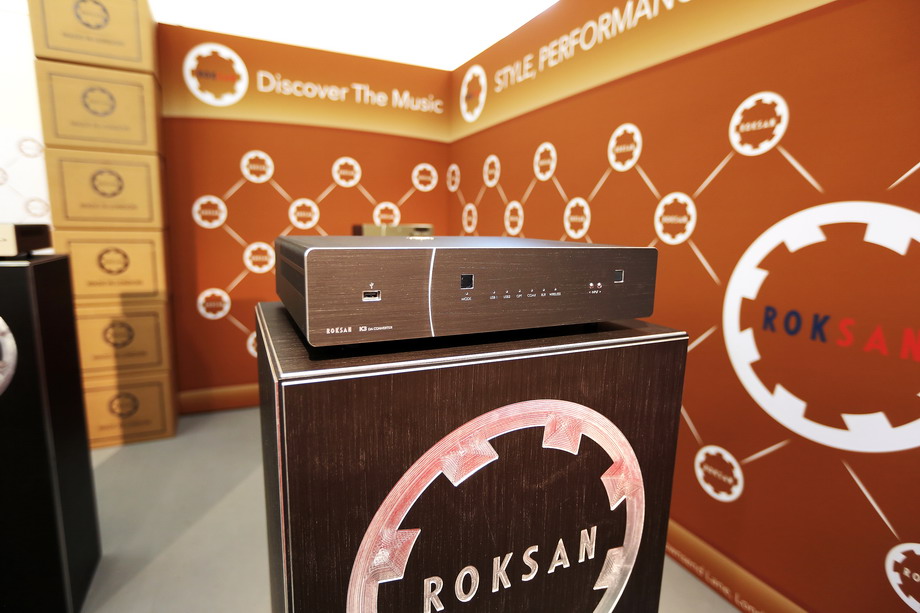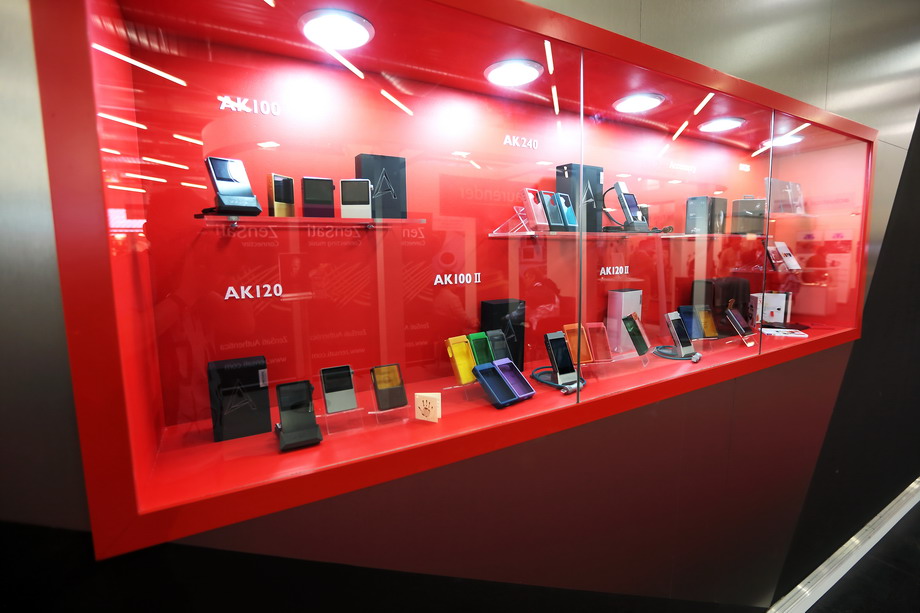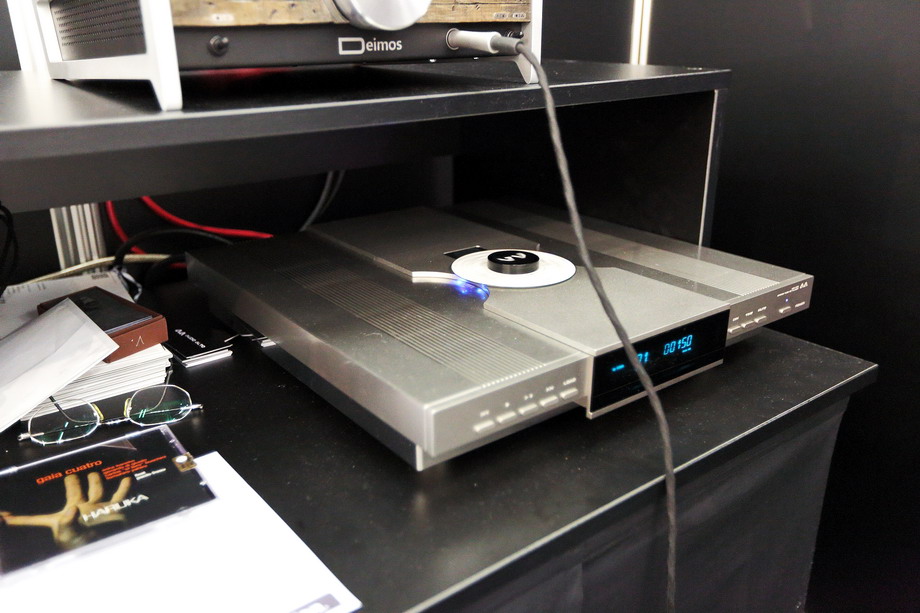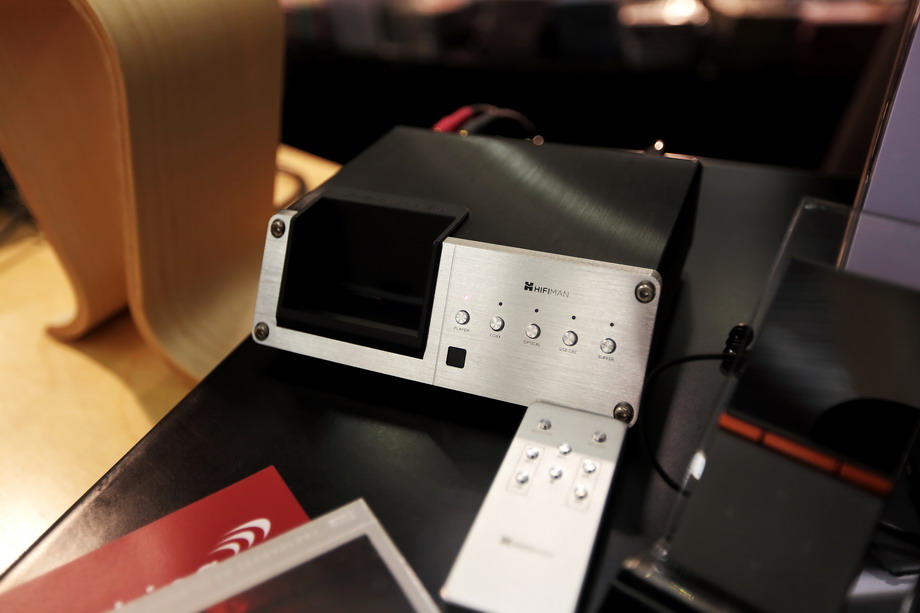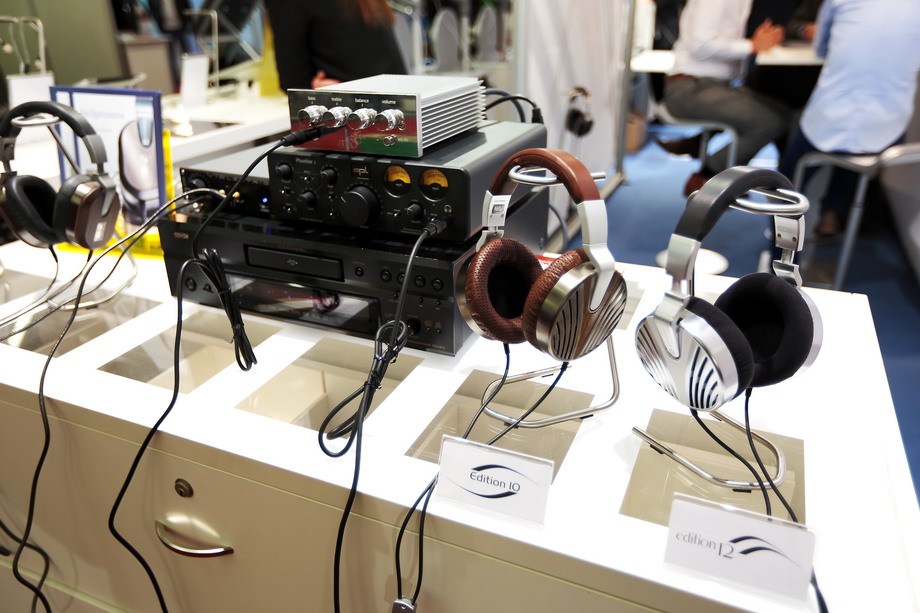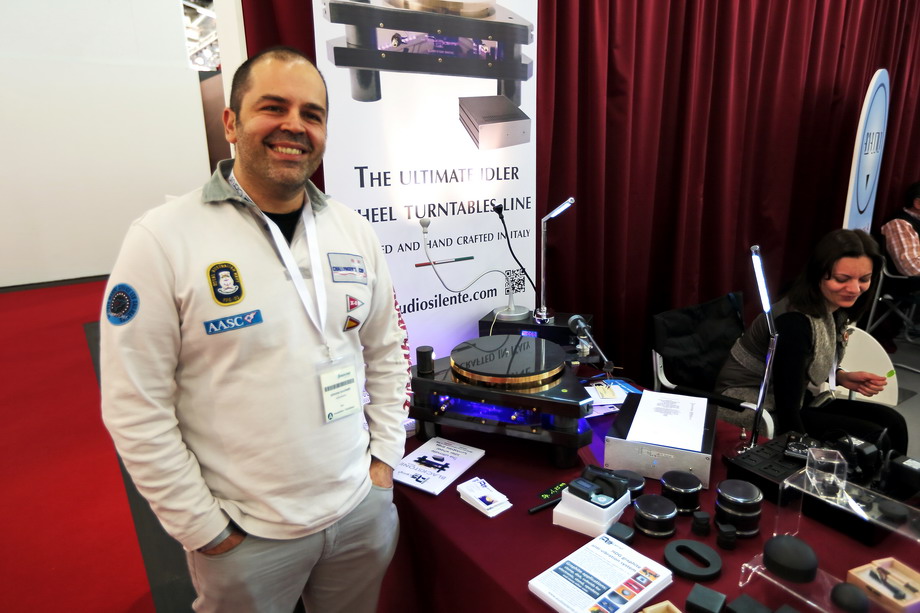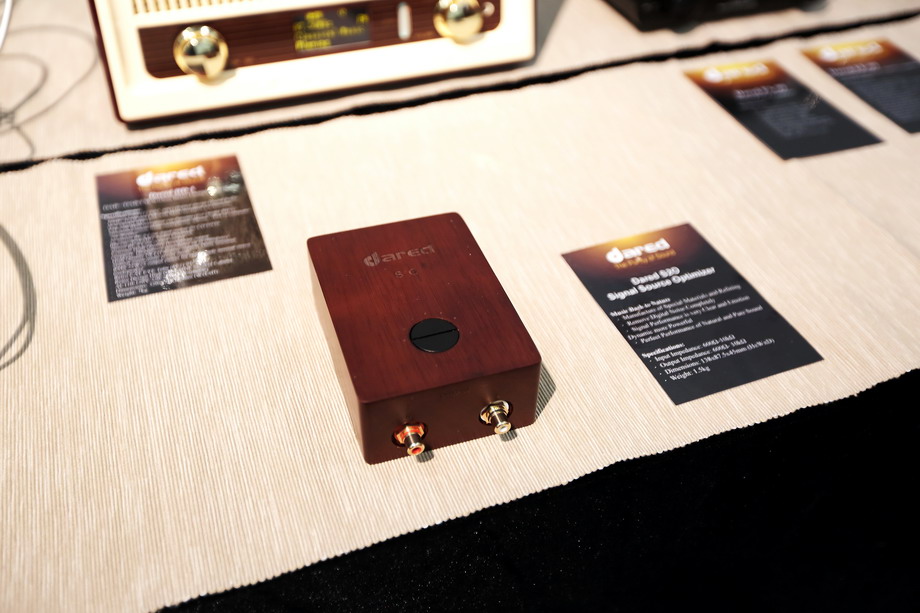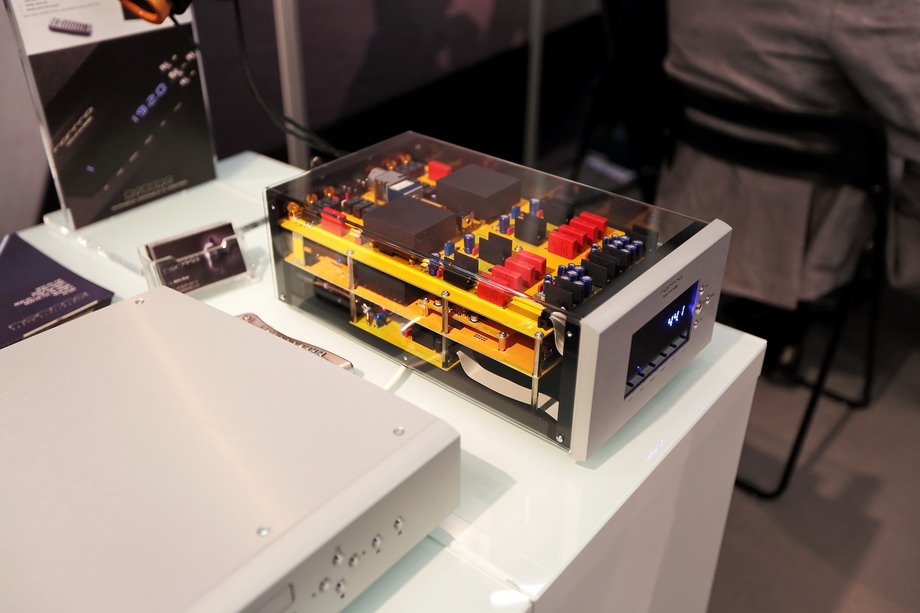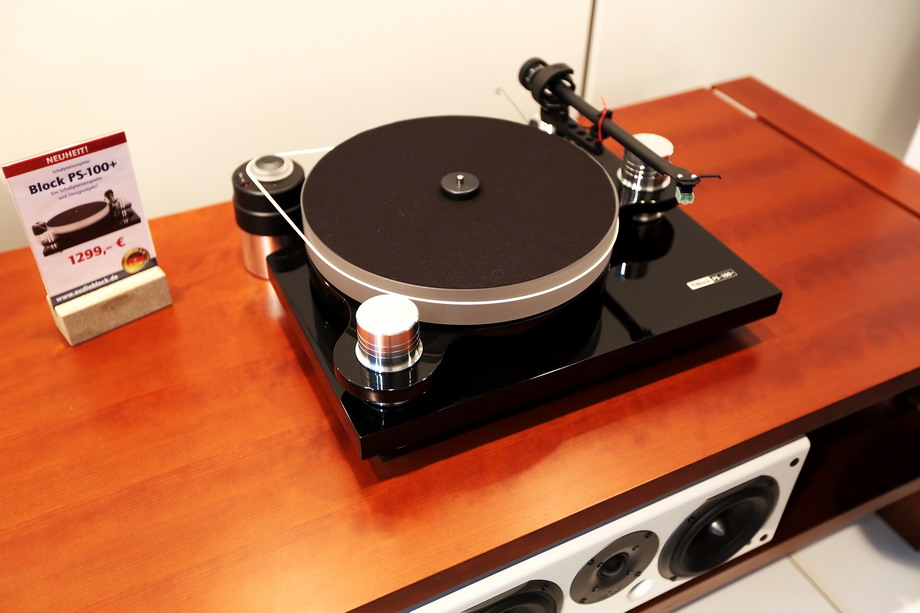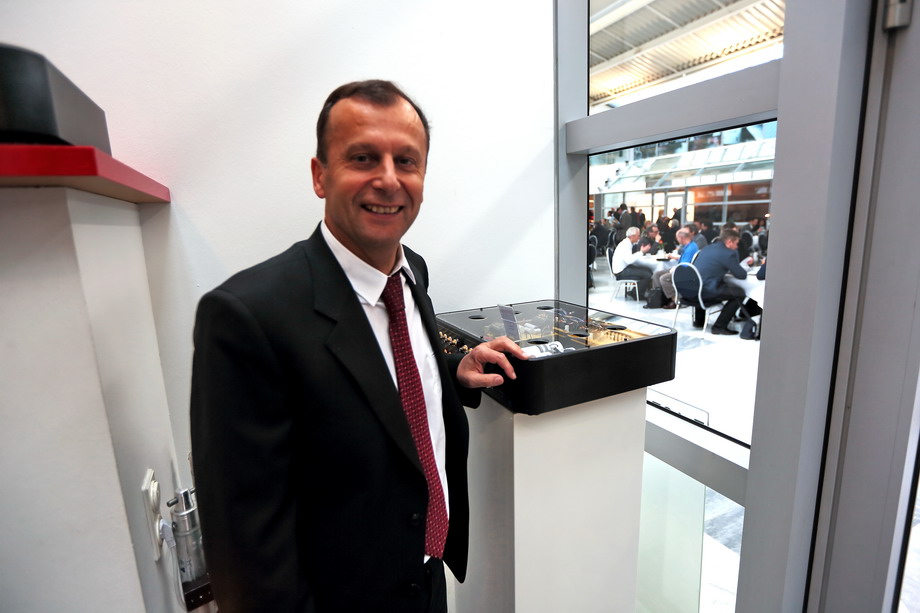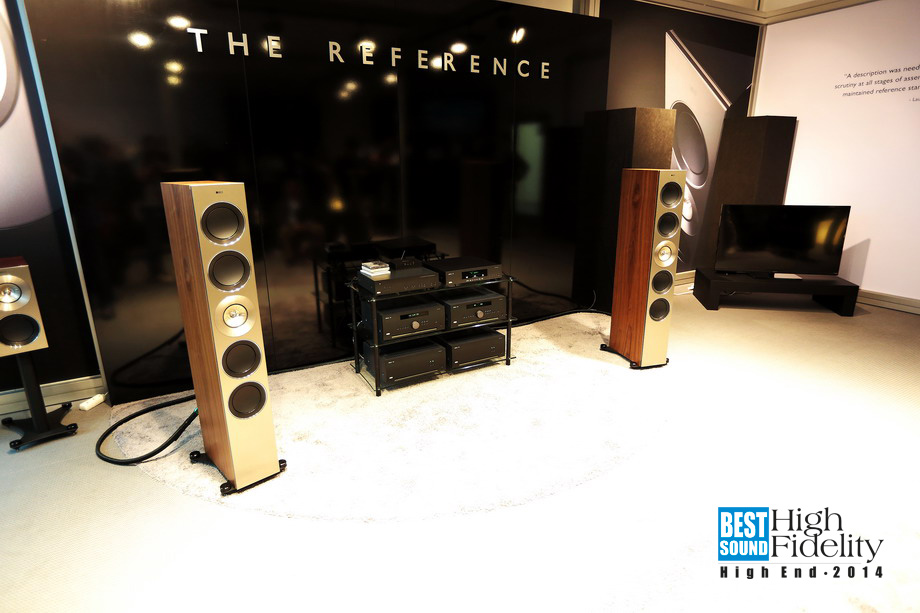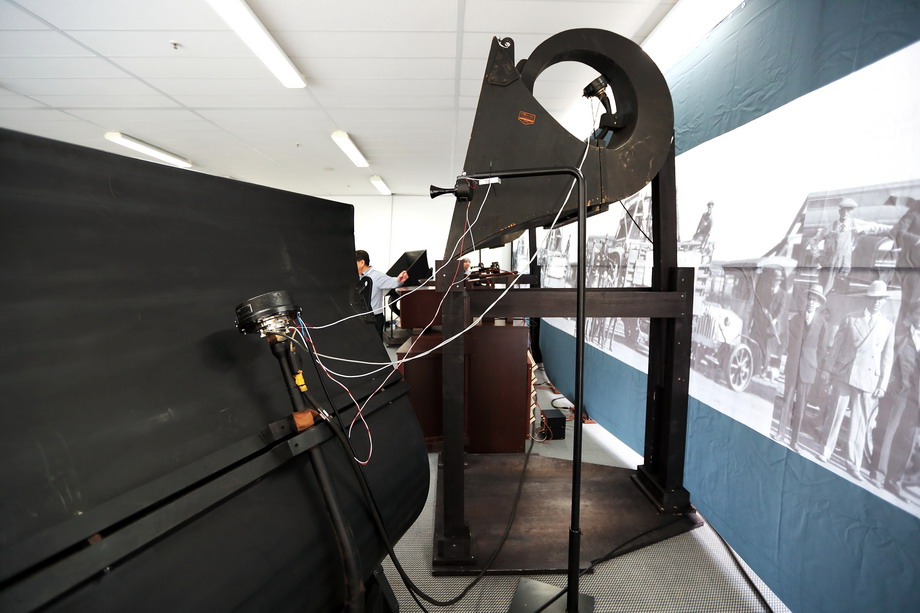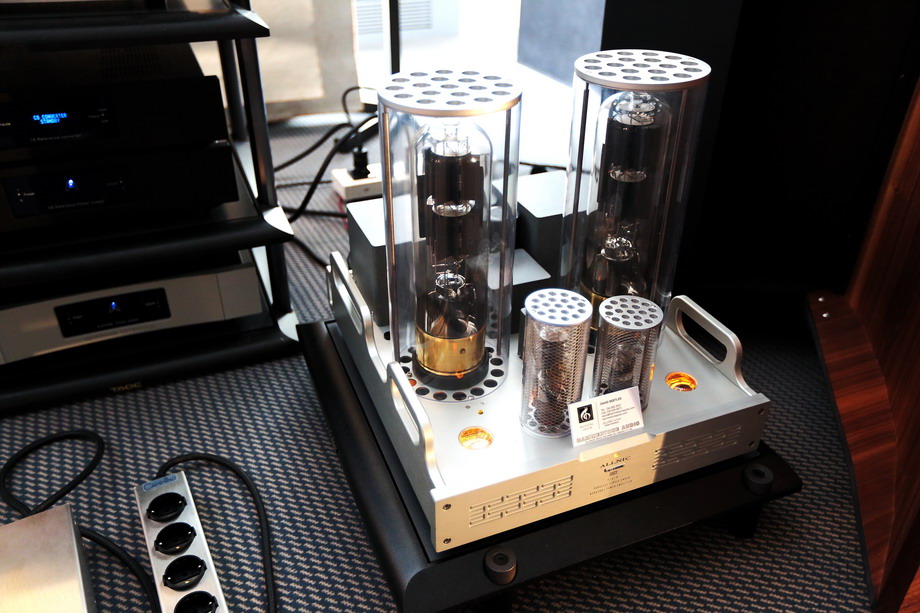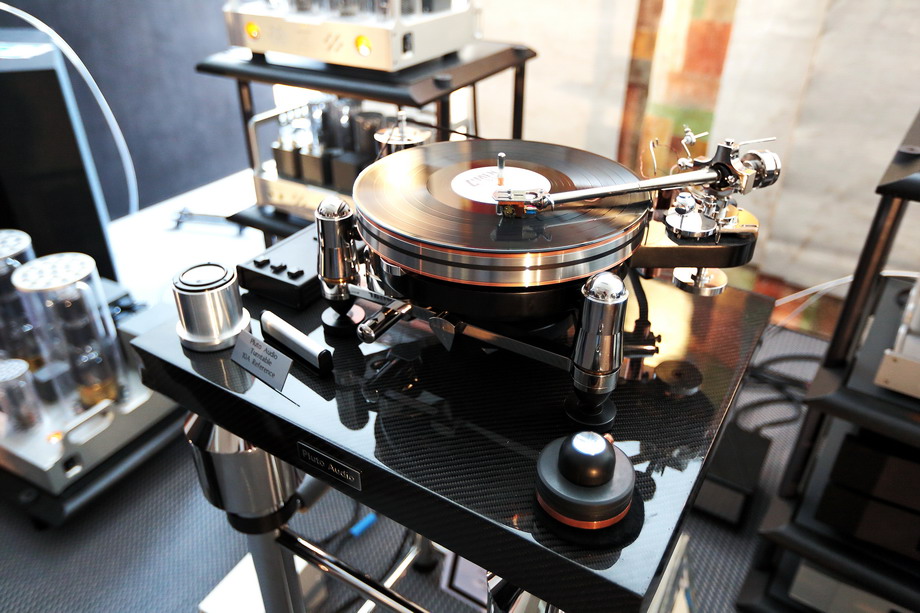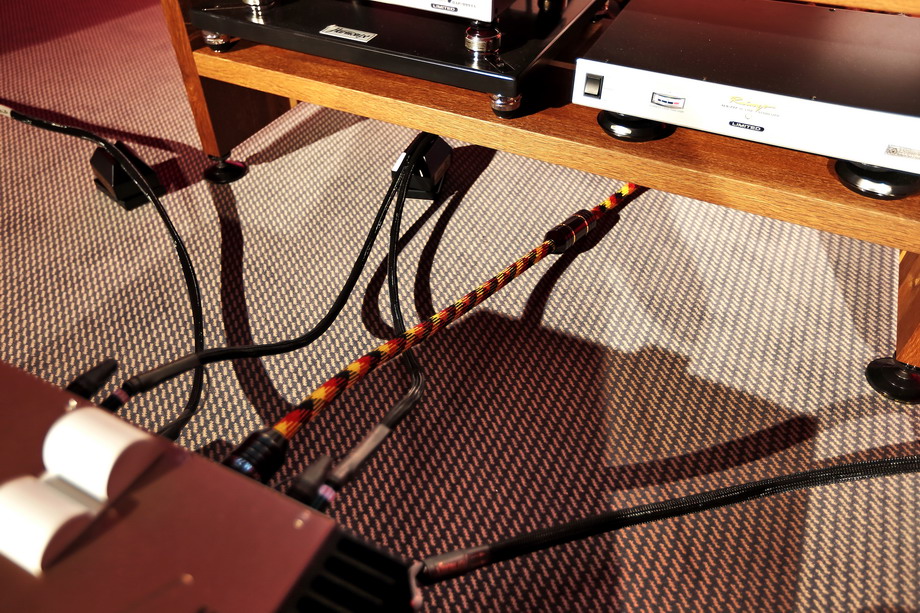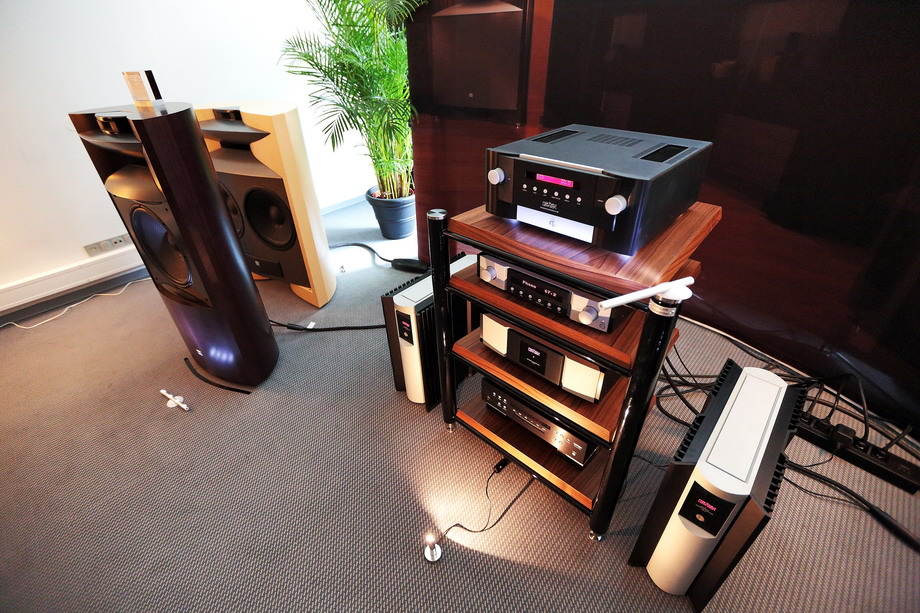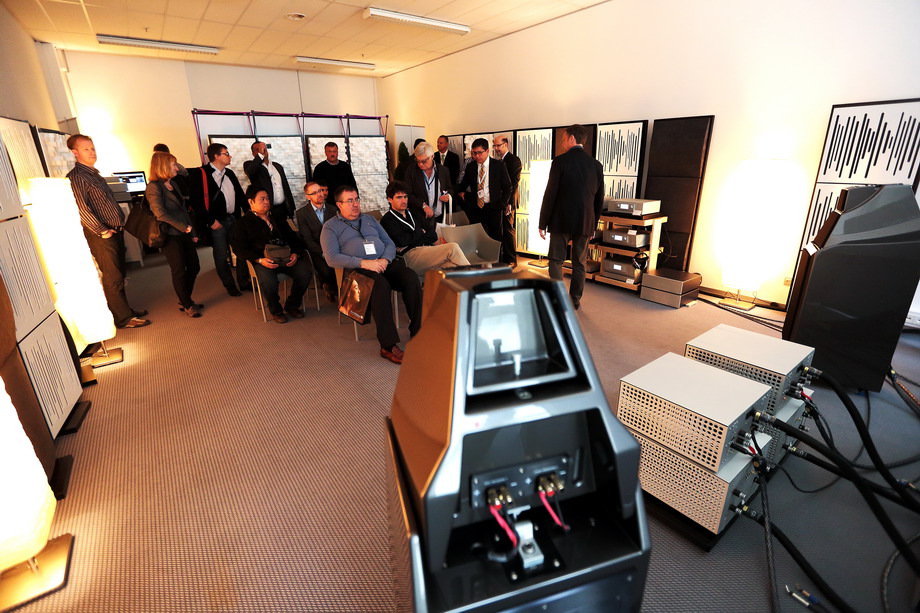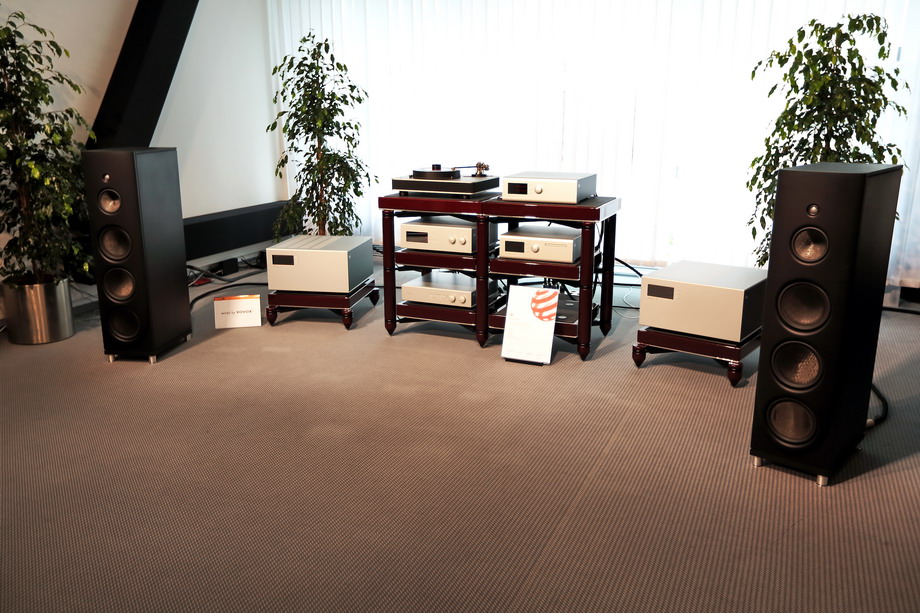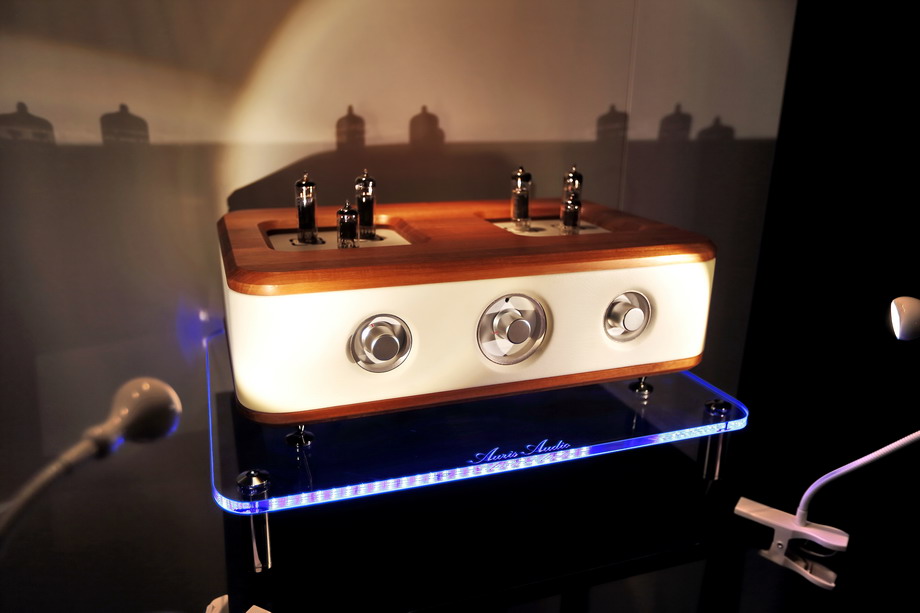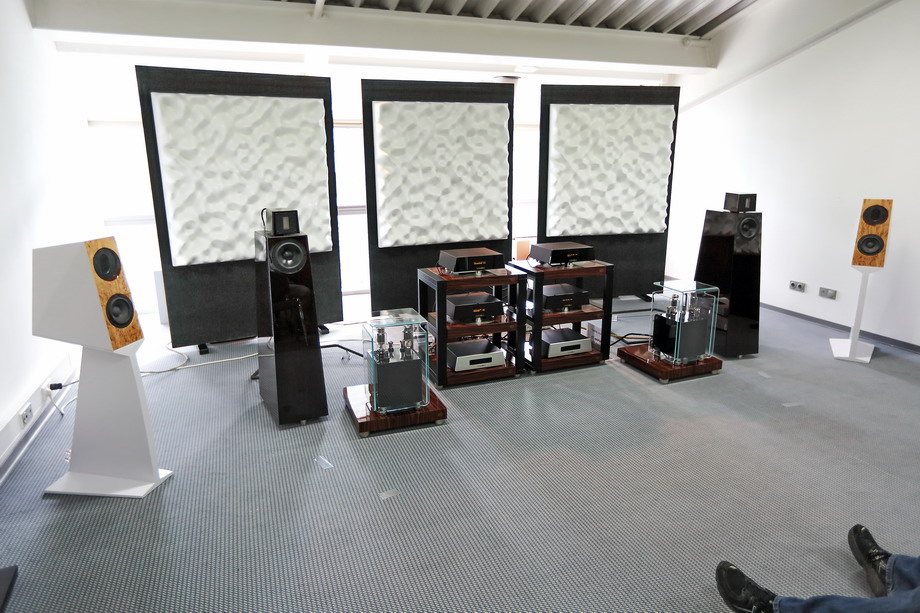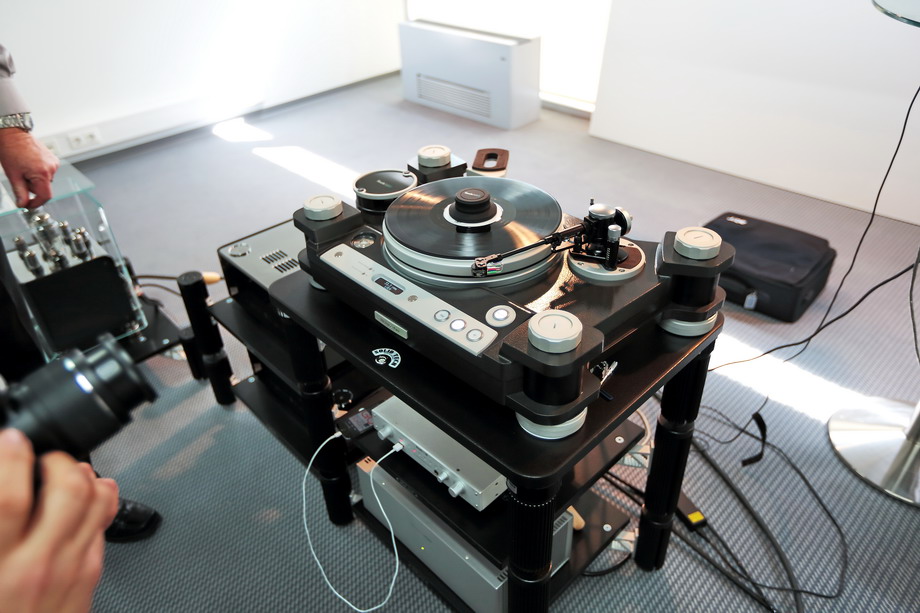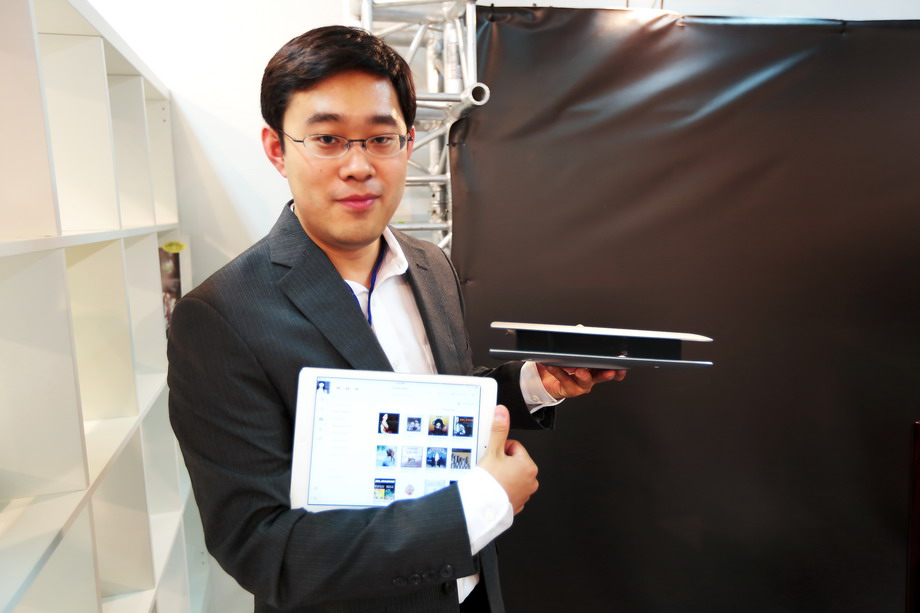|
COVERAGE
HIGH END 2014, MUNICH
Time: 15-18 May 2014
Venue: M.O.C., Munich, Germany |


|

|
As it could have been seen last year, the exhibition area and the sheer number of products were impressive. Any attempt to visit all exhibition rooms and talk to at least some of the manufacturers was doomed to failure. Of, course it is possible to stay in Munich for the whole four days. There’s a good chance then to be able to see almost everything. And there would be some time left for meetings and talks. For some time now, I have been trying to do it all in the shortest time possible. And I don’t want to do it again this way. Instead of trying to catalogue the whole show, I would like to show you those moments that caught my interest, introduce you to the people I respect and like, and to the places I came across by chance. I was trying to document these meetings with photos. SAUNTERING AROUNDThis time I decided to take flaneurism as my methodological principle. I am not the first to use this approach, but it means a significant change in my life. This type of "sauntering" is known primarily from the nineteenth century literature. The flâneur, key figure of the nineteenth-century modernist city, is "a characteristic paradigm of the modern entity," in the words of Katarzyna Kułakowska (Katarzyna Kułakowska, Miasto płci. Dyskurs miłosny Marii Peszek, Warsaw, 2013). She says, after Zygmunt Bauman, a Polish sociologist, that the flâneur has long been brought over from Parisian walkways to everyday life and played a significant role "in building a terrifying universe of the postmodern consumer order" (Zygmunt Bauman, Dwa szkice o moralności ponowoczesnej [“Two essays on postmodern morality”], Warsaw 1994, p. 21). In literature, this method has, for example, been adopted as a research methodology by prof. Dobrochna Ratajczakowa: Methodologically, I'm a flâneur. I set out for a special kind of stroll, not only across various fields of the arts, but also in the areas of the sciences and, like the 19-century flâneurs, I visit not only the shrines of High Art, but also the smoky caffés chantants or (even worse) dubious theatrical freak shows. This flaneuring – thematic, conceptual, theoretical, methodological - allows me to exceed the rigid boundaries of disciplines and to enter fascinating frontiers, combining what is low with what is the highest. Dobrochna Ratajczakowa, O sobie [w:] Ko-medianta. Prace ofiarowane profesor Dobrochnie Ratajczakowej, red. Ewa Guderian-Czaplińska, Krzysztof Kurek, Wyd. Poznańskie Studia Polonistyczne, Poznań 2013, s. 7. Historically speaking, flaneurism is a stroll around the city, no objective, not accidental; loitering, peeping life, "retraction" smells of the city and its moods. The enormity of modern cities does not allow for systematic in their research. To succeed, you need to be cut off from the emotional part. And it's a shame for life. So I walked Nina Simone Way, Oscar Peterson Boulevard, Ella Fitzgerald Avenue (the so-called transition between stalls in the exhibition halls during the High End), rested in the Atrium Atrium 3 and 4 I tried to capture the spirit of the place, remember how many impressions. I hear what you can. THE COMPACT DISC IS DEAD. REALLY?I have found that taking my working band into the studio is too much trouble these days (that is, in 1986, when the album Tutu was recorded – ed. note). The band might not feel good that day at the recording session, or at least some people in the band might not. (…) Doing it the old way, recording like we used to, is just too much trouble and takes too much time. Some people say they miss that spontaneity and spark that comes out of recording with a band right there in the studio. Maybe that's true; I don't know. All I know is that the new recording technology makes it easier to do it the way we have been doing it. If a musician is really professional he will give you what you want in terms of performance in the studio by playing off and against the band that's already down on tape. I mean, the motherfucker can hear what is being played, can't he? Miles Davis i Quincy Jones, Miles. Autobiografia, tłum. Filip Łobodziński, Wrocław 2014, ss. 379, 401. Little did I know that my few words in the review of the CEC TL0 3.0 transport would elicit so many emotions (see HERE). I based my evaluation of the situation with audio signal sources on practice and experience. Saying that audio files are the future, but still have a long way to go to catch up with the increasingly more mature and almost unbelievably advanced (in terms of the amount of time spent on its development) Compact Disc technology, I had no idea that the attitude towards the vinyl-CD-audio files relationship is often closer to religion than reasoning. Being called a "dodderer" or an "old fart with no understanding of the modern world" is actually funny. The only thing is that it indicates a serious deficit of synaptic connections in people who say something like that. And/or their deafness. The above quotes from the autobiography of Miles Davis, a musician whom I greatly respect and who changed jazz several times, suggest the need for change. And he is right; it is impossible not to agree with him. It's just that on a completely different matter, to quote Janusz, the host of the Krakow Sonic Society. For Davis, the change in the way of making music resulted from his explorations, his meditation on what he was doing, on his music and the music of people he valued. In addition to Dizzy and Bird whom he adored, it was Prince but also Michael Jackson. And others. The change was never supposed to oppose anyone just for the sake of it and was rather caused by the very musician’s modified approach to playing music. In the case of changes in the recording technology, I have to say that although I disagree with Davis, I respect his opinion. What eventually won was simply practical – the new was better because it was more convenient. These two levels of understanding of the "new" well reflect the situation with audio files and CD, because they are my main point. Vinyl status seems to be well established: it is a classic that will outlive everything and everyone. A growing movement associated with reel to reel tape is a margin, although it adds spice to what’s going on in audio. Audio files primarily mean convenience. This is how they were created and then adopted by the youth. I have nothing against convenience and this aspect is really OK. Having no physical referent is for many people a symbol of modernity and I'm not going to argue with that, either. If I still had any doubts, the Munich show would dispel them in a flash. The abundance of digital music players and related accessories, so evident over the last few years, this year seemed less noticeable. Based on conversations with audio manufacturers, music lovers, audio magazine editors and dealers, I generally can say that I noticed in many of them a waning of their initial enthusiasm. Perhaps playing tracks from a black box controlled with a tablet has become so normal that there is nothing to get excited about. Walking through the show rooms I could see lots of familiarity with this type of user interface. Its convenience is beyond dispute. High Fidelity.pl 
It was widely felt that this year saw a drop of form. Without too much fuss, I will just say that I did not find too many rooms where I heard something interesting. Most of the exhibitors put lots of effort and money into their demonstrations, and the whole show can be generally called fully professional. It was a place for meetings, for doing business and some small talk. The sound was important, but even more important was the "image": the way a given system or product were exhibited and demonstrated. I must admit that this kind of situation suits me very well. Those who were willing to fight for something more hereby receive a bonus in the form of favorable comments and awards, such as "High Fidelity" Best Sound award. However, all those who opted for contact with visitors, conversation and discussion, they have my highest respect; it was fully professional. As I wrote in the beginning, this report is not an attempt to catalogue the show, but rather some kind of record of my impressions. As such, it is quite random and fragmented, much like the whole reality. But it is my ambition to find in this uncertainty some anchors on which to build. This will help both me and – hopefully – you. Hence, I have given awards to several systems being guided by what might be called "captured attention." If after my first or second, sometimes third and fourth, visit to a given room I had no more desire to listen to music and instead preferred talking about the products and looking at them, it was a sign that the sound was not what was most important there. As I said, I understand and fully accept this strategy. However, to those who managed to prepare something more than that: best congratulations! “High Fidelity” Best SoundSoundKaos (speakers) + Trafomatic Audio (amplifiers) + Lumin (digital music player) 
Ypsilon (electronics + speakers) + Thales (turntable) 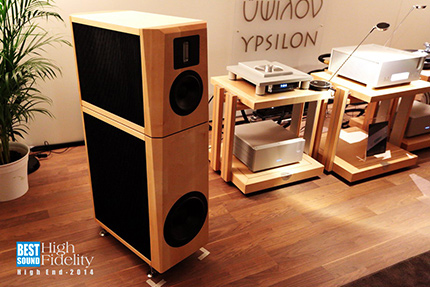
|
Kavero Keiser (speakers) + SPEC (electronics + turntable) + Sforzato Corp. (digital music player) + Acoustic Revive (acoustic treatment, accessories, cables)

JWB Merlin (electronics) + YG Acoustics (speakers) 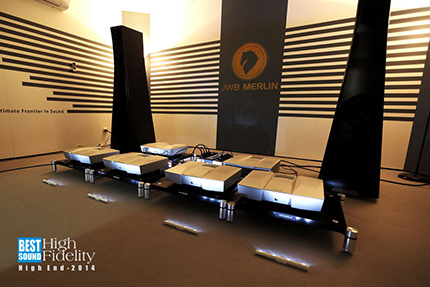
KEF (speakers) + Arcam (electronics) 
TAD (electronics, SACD player, speakers) 
Progressive Audio (CD player + electronics + speakers) + AVID HiFi (turntable) 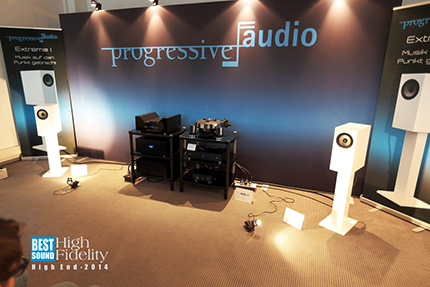
Zontek (turntable) + Linnart (preamplifier) + My Sound (power amplifiers) + Albedo (cables) + Auto-Tech (speakers) + Sound Box (acoustic treatment and hi-fi rack) 
Boenicke Audio (speakers) + Auris Audio (electronics) + Pro-Ject (turntable) + M2TECH (DAC) 
TotalDAC (digital music player + DAC + upsampler) + Keiser Kawero (speakers) + Engstrom&Engstrom (speakers) + Bibacord (cables) 
Zellaton (speakers) + LOIT (CD player) + Wagner Audio (turntable) + Allnico (phono stage) + Analog Domain (amplifier) 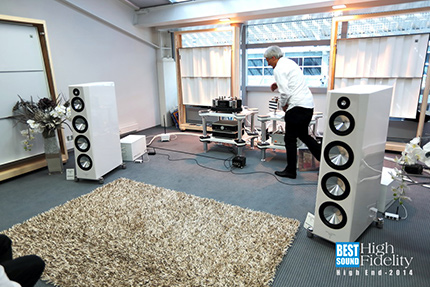
OceanWay Audio (speakers) + Viola Audio Laboratories (amplifiers and preamplifier/DAC) + Nagra (CD player) + Artesania Audio (hi-fi rack and isolation boards) 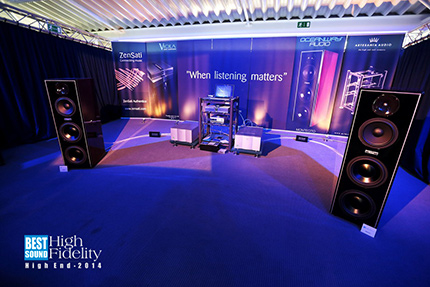
Ascendo D9 (speakers) + (amplifier) + Neodio Origine (CD player) + High End Masterclass (hi-fi rack and isolation boards) 
Special awards go to:
What’s left after the show? First, the certainty that the Compact Disc is still in great shape and will remain with us for a long time, just like vinyl. Audio files sound slowly getting better. More importantly, however, it seems to me that the whole audio industry is doing well. Just as I have been saying for a few years now, the youth listening to their MP3 players, then iPods, and now iPhones at some point matured enough to demand something more. They demanded quality. And it is these young people who will be spending most money in the next few years. The largest record companies have recognized a great potential and start to offer high resolution files. This is extremely important because their catalogues include the vast majority of classic jazz, rock and classical music. The related reactivation of the headphones as an equal way of listening to music is now a fact and has resulted in outstanding designs, mostly planar. Class D amplifiers become more refined and in the middle price range must be seriously considered on a par with class A and AB. In the beginning and top of the price list, the classic technologies seem to still have an advantage. I would like to thank everyone who helped me during the exhibition, for their hospitality, warmth and selfless help – many thanks! |

- Ansi Hyvönen, head of Amphion, in front of the speakers with grilles in different colors. And with HF cover in his hands
- The long-awaited Rubicon, shown for the last two years as a prototype, a digital-to-analog/analog-to-digital/headphone amp from Antelope Audio. With an ultra-precise master clock on board.
- Georgi Lazarev, head of marketing at Antelope Audio, says that the cause for Rubicon’s delay were the results the company achieved with the cheaper DAC. It forced some changes upon their flagship model, which took them over a year to complete.
- Tools Of Light is a company that uses a… light barrier in their power supplies. Similar to Siltech amp, there’s a high-energy optical link used as a barrier between the distorted “primary” side, and the “clean” output side.
- You might remember the review of speakers from Langerton, a German company; pictured is their biggest model, next to Walter Langer, the designer. The Duo Capable speakers consist of two modules, with a midwoofer and a separate large ribbon tweeter.
- Onyx is quite well known – pictured is its XIA-160SE integrated amplifier.
- After launching the Lumin file player the manufacturer now offers four components, and the pictured T1 is a slightly simplified version of the original Lumin.
- Headphones are in vogue – the Audeze LCD-XC closed magnetostatic headphones are pictured connected to the new headphone amplifier from SPL, the Phonitor 2.
- The SPL Phonitor 2 headphone amplifier has great-looking VU meters and offers the possibility to re-create the original room acoustics.
- Mister A. Miura is a man of advanced age, but still full of ideas for the future. As he revealed to me, next year he’s planning the premiere of new monoblocks – new releases are always a big deal with this company.
- Lab12 is a Greek company, completely new to me. The Mighty amp, pictured here, isn’t big, but it looks great and delivers 9 W per channel in class A from EL34 tubes.
- This is one of the possible preamplifier designs – a passive circuit based on transformers with switchable taps. The company is called Bespoke Audio, and the preamplifier is their new reference.
- This small, stylish box is a component from Poet Audio called the Pandoretta. The sound spreads nearly omni-directionally out of this “Pandora’s box”. It contains the Bluetooth aptX receiver, 7 speakers and 170 W amps. All you need to do is supply a signal from an iPhone, for example. A great matching table is available, too.
- Many of the companies present at the show came from Greece, such as Tsakiridis that specializes in tube amplifiers.
- There are quite a lot of new tonearms on the market, as well as upgraded designs. Pictured is the WE-308sxl arm, almost entirely re-made by the German company fonolab.com, with a stabilizer from SAEC.
- Creek Audio new Evolution 50 player, with an amp of the same name. The British are clearly still “in the game”.
- Croft Audio is practically unheard of in Poland. But why? They offer truly wonderful, and reasonably-priced tube-based components. Pictured is the RIAA phono preamplifier which costs 1,200 Euro, and below it – the Micro 25 line preamp which costs 980 Euro.
- The properly-celebrated premiere of new speakers from Harbeth, the Super HL5plus. The most important change is the material used in the midwoofer – it’s Radial 2 now, the same one as in the M30.1 and M40.1.
- Ah… The Obravo HAMT-1 headphones, beautifully looking and very interesting sonically. Their unique design stands out from the others – they’re the first coaxial headphones in the world with the Hail transducer at the top and a dynamic one with neodymium magnet at the bottom.
- Mr. Peter Lyngdorf is known as the designer of the first TacT digital amplifier to win a commercial success.
- Peter Lyngdorf is currently developing his own ideas, including those in the field of acoustic room treatment, at Steinway & Sons, for which he prepared a complete, huge system.
- Pure Audio Project is a company offering some interesting-looking DIY speakers. Their design is their characteristic trait – these are open baffle designs. There are several versions available.
- Pure Audio Project speakers are put together like puzzle pieces – with comfortable cut-outs. If you get bored, you can get particular speaker modules replaced.
- This photo needs no comments: Pro-Ject in all its analog glory
- Pro-Ject in all its digital and amplification glory. New S series components.
- The long-awaited, two piece CD player from the RS series, consisting of the Box RS CD transport and Box RS DAC. The transport is a top-loader!
- DACMagic XS (as in eXtra Small). This miniature D/A converter and headphone amplifier in one from Cambridge Audio is a convenient method to turn your computer into a high-quality signal source with minimal costs.
- One of the most important premieres in Munich, to me – the Block amp from G Lab Fidelity Design, a Polish company. Excellent build quality and creative design, with a separate power supply module, output transformers and electronics (in one case, though), are its main characteristics. I’ve ordered it for a review.
- I just want to tell everyone at G Lab Fidelity Design – great work, guys!
- ADL, Furutech daughter company, presented their new DAC/headphone amplifier, the Stratos. It has USB inputs, among others; PCM processing up to 24/192 and DSD up to 5.6 MHz.
- The Greek company Ypsylon has visited world-class shows many times prior, largely due to Michael Fremer’s wonderful reviews in “Stereophile” magazine. This year’s presentation fully confirmed the positive opinions. The main attraction was the hybrid Phaethon amp (middle). The system sounded equally good when driven by the Thales TTT-Compact turntable, as well as a two-piece top-loaded CD player: the CDT 100 + DAC 100.
- Hanging speakers from Architettura Sonora – spaceship-shaped in the foreground, and dolphin-shaped in the background. They work great in minimalistic interiors.
- Our friend, Mr. Ken Ishiguro, who has already visited our Krakow Sonic Society. This year he presented completely new set of cable models. The company literature suggests that Furukawa, Japanese supplier of high purity PCOCC-A copper, 2.4 x 2.6 mm long crystal cables, has ceased their production. Therefore, the entire branch had to go search for something different and better. The chosen alternative are CCC cables, manufactured in a process similar to how the metal is processed while forging samurai swords.
- SPEC GMP-701 turntable, finally ready and working. It has a heavy, wooden base and a massive platter. The speed switch and manual speed controls are on the side.
- A man of extraordinary hearing and craft talent, Mr. Tsutomu Banno, next to the company’s newest amp, the RSA-F33.
- Another Japanese master (and I really mean that), Mr. Omata Kyoichi, representing Sforzato Corp. The company manufactures small and refined digital music players.
- The Acoustic Revive room as always exuded calm and beautiful music. This year, the company decided to use the Kaiser Acoustics Kawero! Classic speakers. Worth noting are the enlarged, almost floor-to-ceiling acoustic panels.
- Concrete Audio, straight from the Weimar region in Germany, has some interesting speakers in concrete enclosures. Although the idea isn’t new, most past executions were far from successful. This time, there’s something good going on.
- One of the many CD player premieres at the show, but definitely a the better-looking one: the HD26 Golden Music player from DestinY. It’s a top-loader type with a big, slide-out cover and 12AU7 tubes in the output.
- A stand for all of those who are just getting started with their business: a direct drive turntable from the German company Langer.
- Direct Drive Langer Audio, a part mounted to the base.
- Another “startup”, Mr. Anastasios Vardaxoglou, head of the Greek company Audio4Soul. He’s standing next to a digital music player with a modular design, which allows you to upgrade it into a much better-refined form, with other elements inside and outboard power supplies.
- Ooh – I just wet my underpants… the Nagra T-Audio TC reel to reel tape recorder in all its glory. It was proudly displayed on the stand of a company that offers copies of master tapes produced in the patented A4P (Analog 4 Phases) technology – the Italian company Hemiola Records.
- I’ve written about Tacet in every single one of my reports from Munich. It’s led headed by Mr. Andreas Spreer, the owner and main sound engineer. Mr. Spreer records onto analog rell to reel tape recorder using a few tube microphones. He also cooperates with Polish orchestras. He releases music on SACDs, including multi-channel discs (he was one of the pioneers of using multiple channels on DVD-Audio discs), and on vinyl. He is pictured holding a disc with test signals, one he is especially proud of.
- Diapason is an Italian company with tradition. It’s hard to believe that it’s already 25 years old.
- This is something for me: the Italian company Thoole makes enclosures for the Tivoli Model One radio, which I’ve been enjoying for the past few years. Who knows, I might give in to the temptation. They also offer stands for headphones and speakers, as well as racks.
- ENIGMAcoustic Mythology M-1 speakers with an incredibly interesting, electrostatic ultra-tweeter. It looks phenomenal.
- Alan Shaw, the owner and designer of Harbeth Audio UK, busy talking, as always…
- Another interesting CD player, a top-loader from AcousticPlan (Germany) named Vadi. Tube output, and a Philips CD-Pro2M drive.
- The gentleman on the left recently visited us in Kraków: it’s Jonathan Brooks-Martin. Keith Martin – his brother, but also boss – is on his right. Keith is also the head of Isotek, where both of the brothers work.
- Mytek directed its products to the pro audio market. Despite that, they’ve been bought by “ordinary” music lovers for years. These DACs lacked the looks that an average person would accept in their living room, though. This is supposed to change now – pictured is the amazing design of the company’s new product, the Manhattan DAC based on the 192-DSD Stereo DAC.
- Polish roots are quite the connection: Lipinski Sound and Mytek companies, together. Mr. Noël Coquet from Lipinski Sound is on the left (he speaks surprisingly good Polish), and on the right we’ve got Mr. Adam Bielewicz and Mr. Marcin Hamerla, representing Mytek. They also speak good Polish :)
- Vicoustic is a company specializing in acoustic room treatment. I use their products, but I don’t have anything like this, yet – it’s a tuned bass trap.
- An Asian’s wet dream: the whole Residential series from Tannoy, with the powerful Westminsters at the end.
- The German company Ultrasone prepared this year a new series, the Edition 5, limited to 555 units. I couldn’t resist the temptation of their Julia headphones, though.
- Beyerdynamic is one of the leaders on the headphone market. For the show, the company prepared the T90 Tesla model, celebrating its 90th anniversary.
- Acoustic Signature did not fail to deliver – pictured is their new Novum turntable with the Silencer 2 platter, a re-made version of the Silencer, as well as a betaDIG microprocessor and space for two arms. Weight: 43 kg, price: 16 499 Euro.
- An interesting presentation of Lawrence Audio speakers, driven by Avantgarde Acoustic electronics and the Puccini player from dCS. Pictured is the Cello model with six speakers: 12 and 8” woofers and three ribbon drivers – to handle midrange and treble. In the background you can see a conditioner from the Polish company Gigawatt.
- Mister Peter Cheon (left) is a Korean; he is the owner of KLAudio, a company presenting an incredibly well-made KD-CLN-LP200 vinyl record cleaner. The discs are washed with ultrasounds, coming into contact only with the washing solution. Now they also offer a disc changer for a reduced contact with the cleaner, as well as a noise-damping enclosure.
- Do you remember the Paragon speaker system from JBL? We now have its “nobler” version made by Lyravox. The Stereomaster system from Germany is intended to be hung on a wall. Its finish quality is like that of the best furniture – it will play CDs and amplify their sound.
- Music Hall presented new versions of pretty much all their turntables, now with a .1 at the end of their model names. Pictured is the mmf-7.1 model.
- The British company Roksan presented totally new series of their products. Pictured is their K3 DAC with two USB inputs and wireless connection.
- Mr. Arthur Khoubesserian is a nice, good-humored gentleman. At the show he presented his latest Funk Firm Little Super Deck turntable. It so happens that I reviewed it in the same edition of “High Fidelity”.
- A system that made a huge impression on me. It included speakers from PMC and Black Pearls electronics: the Virgo CD/file transport, Aries DAC, and the Birth 100 integrated amp. The company is from Greece.
- You can’t deny Astell&Kern some panache and cool ideas. In Munich, they presented a whole spectrum of components, all of which seemed to be competing among themselves to be the best-looking one.
- Astell&Kern flagship product, the AK240 file player – it’s just beautiful. I listened to it using the Ultrasone Edition 5 headphones and it was great.
- One of the funnier-looking products. Jarrie Technologies presented a system shaped like a skull: the speakers are in the glasses, an iPhone can be plugged in from the top, and you use a human bone-shaped remote control.
- Italians at their best: Care Orchestra bedroom system, including the Celestial Voice amp and Celestial Rose speakers. The company head, Mr. Alessandro Reggiori, said that this is the first amp in their lineup. There are 12BH7 tubes at the input, and solid state output stage. The power output is up to 180 W at 2 Ω.
- Electronics from AM Audio from Italy. In the background you can see the massive A-300X Excellence power amplifiers that boast hundreds of watts of pure A-class power.
- Claudio Cordone (right) is the owner of AM Audio. He received this friendly gesture from Simone Lucchetti (whom you’ll see more of, soon) who was set up next to him.
- The Erzetich Deimos amp worked with a top-loader CD player. Unfortunately, I couldn’t find its name, aside from “High End Tube CD Player”.
- HiFiMAN finally showed a dock for the HM-901 player. It’s big and solid, has a built-in DAC and digital inputs, so it can work as a system’s “center”. The remote control comes included.
- Ultrasone Edition 10 and Edition 12 with headphone amplifiers from Transrotor (that’s right!), SPL and Violectric.
- Mr. Franc Kuzma wasn’t showcasing anything particularly new this year, except for the new color finish of the M model. But he gladly signed the cover of “High Fidelity”.
- In the audio world a company seems to be glued to its products. It’s a very conservative business. That’s why I don’t know how these “rocketships” manufactured by the Swiss-based JWB Merlin will be received by the community. Pictured is their No. 214 amp.
- Regardless of how the market reacts to JWB Merlin, the sound of their products paired with YG Acoustics speakers was incapacitating. Dense, dark, but exceptionally resolving. As if it were a tube amp, but also a kind of Soulution-like solid state design. Bravo!
- OPPO is a company known mainly for its great Blu-ray players. This is its debut in the headphone market, but it stormed right into it with a system composed of the HA-1 headphone amp and PM-1 magnetostatic headphones, with a balanced connector.
- A cross-section of the strangest, funniest-looking speaker at the show, which aimed to show that it’s an unbelievably advanced design. Manufacturer: The Varios. Country of origin: Italy.
- Pictured is The Varios Los Angeles and, in front of it, a tiny tweeter that could be put on top of it.
- When Bartek, HF’s graphics designer, saw them he said that he could just about picture them in a modern, minimalistic interior. It’s true: the speakers from the Italian company Audel are truly beautiful. Their cabinets, made of plywood, but cut perpendicularly, with matching stands and different-colored front, really look unique.
- The camera focuses elsewhere, but I couldn’t just keep myself from showing you this photo: it’s a unique Italian design of a turntable drive. The motor turns a flywheel through a drive belt, and the flywheel connects to an idler. The company is called Audiosilente and comes from Italy.
- We’ve seen this man before, somewhere :) It’s Mr. Simone Lucchetti, the owner of Audiosilente.
- Dared from China surfaced last year. This time it also presented a few new products, but my favorite was a small wooden box, which houses the S20, a kind of passive buffer, similar to what you’d find on MIT cables. It’s supposed to improve signal phase response. Hence its name: Signal Source Optimizer.
- We’ve written about Norma from Italy several times before, maybe this time we should consider a review for HF? The components, as you can see, are the product of some solid sound engineering. Pictured, in the background, is the HS-DA1 DAC.
- What the audio world really lacks is some quality-published literature. But that’s changing. Here you can see books published by Fidelity Books, a brand owned by the “Fidelity” magazine. Unfortunately, they are only available in German, and I don’t speak it.
- You can see this turntable in the current edition of “High Fidelity”: the Thales TTT-C. It’s equipped with the new, less expensive Thales Easy arm.
- Avantgarde’s banner was chiefly carried by the Zero Pro speakers, driven from a reel to reel tape recorder, among others.
- After their integrated X-i60 and X-i90 amps, the French company Advance Acoustic prepared some new, more expensive components, such as the X-Cd3 CD player with a slot transport drive.
- This is Advance Acoustic’s journey into the high-end: the EXCEPTION X-L1000 speakers and X-i1000z amp from their new Paris series. The speakers are still prototypes, but they’re supposed to be available soon.
- Ken Ishiwata on duty, spending another year showing the advantages of special speaker positioning. He toed in some cheap monitors so their axes intersected about a meter in front of them. The sound was surprisingly coherent and well-balanced. It’s worth trying at home. .
- The German company Block isn’t just about inexpensive, solid electronics – they also make turntables, such as the PS-100+ pictured here.
- There’s only one place you get to rest on a couch like this: McIntosh’s station.
- McIntosh, which has recently been purchased by its employees (employees buyout) from an Italian holding company, puts extra emphasis on its American heritage.
- The gentleman with Audeze headphones on his head is immersed in the music from the new HMA100 headphone amp. It’s just wonderful! The amp is also equipped with digital inputs, including USB, so it’s also a DAC.
- Gerhard Hirt is an old friend of ours, and you can see him here standing next to the long-awaited Spheris III preamplifier. It took his engineers three years to fight the difficulties with the volume control circuit, which is a combination of reed switches and transformers. The smile says it all – it must’ve worked, clearly :)
- The newest addition to the Ayon line, a DAC with a preamplifier called the Sigma. It’s meant to sell for 3750 Euro, which is rather not much for this company.
- The KEF Blade model was a break-through for the company, because aside from looking awesome, it also introduced a lot of fresh design solutions. Turns out, it spawned an entire series, including the smaller Blade Two (the color isn’t quite blue, but it’s somewhere in that range) and the new Reference series.
- This year KEF and Arcam’s displays captured my attention for a longer while. The KEF Reference 5 speakers worked together with Arcam electronics: the C49 preamplifier and two P49 power amps, used as monoblocks. The source was the BDP300 Blue-ray player connected to the D33 DAC. Fantastic sound!
- Still in a prototype format, but already working: the newest and at the same time smallest monitors from TAD.
- I have no idea how the Japanese from Silbatone Audio managed to transport all these monsters. But it looked insane: the oldest true speakers, manufactured by Victor Talking Machine, originally belonging to Electric Western Production, come from the 1920s and 1930s.
- In the foreground you can see speakers from G.I.P. Laboratory, with the Western Electric 12A behind them – on the right, you can see the extremely rare Western Electric 13A speaker manufactured for Warner Brothers in 1926.
- The drivers for all the speakers were made by G.I.P, except for one: the Western Electric 597A tweeters, visible next to the Western Electric 12A speakers.
- Allnic Audio is a German brand specializing in tube devices. Pictured is the A-10000 power amplifier with the KR Audio 610 power triodes. This is the first time I could see these tubes in products made by someone other than KR Audio.
- The Pluto Audio 10A Reference is a special-looking turntable. Copper in the platter certainly helps with that.
- I’m impatiently waiting for new speakers from PMC. This time they were rewarded with a new floorstander from the Twenty series: the Twenty-26, with a large dome midrange driver.
- Peter Thomas, the head of PMC, in front of photographs of the company’s customers, including Tonny Benett and the band Kraftwerk.
- Mr. Kazuo Kiuchi, the owner of Combak Corporation, wasn’t in Munich this year. But there was his incredibly-expensive Harmonix X-DC Studio Master “Milion” Maestro power cord.
- The completely new design from Bravo!, Mr. Kiuchi’s brand, the Encore stand mount speaker with a SEAS coaxial driver.
- An inside view of the flagship No. 53 monoblocks in D-class from Mark Levinson.
- Fresh stuff from Mark Levinson, the No. 585 integrated amplifier, with a DAC board, which also accepts USB signal. The attenuator is an advanced circuit with switchable resistors.
- Harman Luxury Audio Group has Mark Levinson and JBL in their portfolio. The K2 speakers are in the foreground – they sound great!
- Constellation Audio electronics, ridiculously pricey, with Wilson Audio speakers – also very expensive. Vicoustic panels on the walls.
- Constellation Audio’s room. That’s what most of the rooms looked like on the opening day, the one available to the press and dealers. Later on during the show, they were impossible to enter.
- I knew these speakers from pictures, but never saw them live: the Magico Ultimate III, taller than me, and costing over 600,000 USD.
- Electronics in the Magico system: Pass, EMM Labs and a professional D/A converter, the Pacific Microsonics Model Two (HDCD).
- The basis is a mighty bass horn, supported from the bottom by a classic driver, though.
- We reviewed an MBL amp from the Corona series not that long ago, and take a look at this shiny new stuff: the N51 preamplifier and the N31 DAC/CD player. Both of them are also available in white, which has been very popular amongst buyers for the past two or three years.
- One of the cooler options offered by Naim is the step-by-step upgrade of your system through replacing the outboard power supply. The German company Phonosophy has existed for years, and their offer includes extreme power supplies, as the one can see on the picture, with a transformer that has the diameter of a World War II anti-tank mine.
- Although Soulution components never sounded nearly as good at the audio show as they did in my home, they still kept their high predictable level. This year, a lot of new things were presented alongside the Magico Q5 speakers, including: the 725 preamplifier, presented for the very first time at the CES show this January, and the 560 DAC with zero-phase technology. My 710 is still waiting for a comparison to the new 711. The turntable in the system is from Dr. Feickert Analogue.
- A veeery good presentation with hybrid power amps from Thrax, a phone preamplifier from the same company, and electronics from Ypsilon. The turntable: Bergman Sindre. The speakers: Rossofiorentino Florentia, the flagship model from this company. The cables: Kubala-Sosna.
- Johnnie Bergmann, the owner of Bergmann Audio, a turntable engineer, next to his upgraded Sindre model. The upgrade mostly dealt with the air pump.
- A lovely, lovely, tiny little cutie: iFi and the Retro Stereo 50 system – an amp with a DAC and speakers. The amp reminded me of Luxman latest amps, and the speakers looked like the classic BBC LS3/5A.
- Heritage SACD Orpheus Labs is a damn complex and advanced design. And it also has a big display screen :)
- If something sounds remarkably well several years in a row, it can’t be a mistake. I have no other choice than to give the Best Sound award to the system put together by Progressive Audio, once again. The system included the Phono 1 phono preamplifier, the A1 power amps, and the phenomenal – although very small – Extreme 1 speakers. The sources were, alternatively, the CD 2 player and the AVID HiFi Acutus SP turntable.
- An interesting system from Wagner Audio: the Concerto Grosso turntable with Dynavector DV 507 MK II arm and Dynavector Te Kaitora Rua cartridge. Electronics: Trigon. I can’t remember the name of the open baffle speakers.
- I’ve already talked about Graham Audio speakers, but I met them once again, in a very good company: with Mr. Tim de Paravicini in the EAR Yoshino’s room.
- Along with the electronics from LUA, a company founded and directed by Mr. Helmut Lua, the oldest alive engineer from Telefunken, stood the Violin turntable from Audio Fonica, in its gold version.
- This is what the packaging of every turntable should look like. And this is a turntable made by a Polish company, Audio Fonica. We sure know how to stay classy!
- Wolf von Langa clearly has a huge house. The speakers on the photo are a lot bigger than the already-enormous Tannoy Westminster Royal/GR. The speakers use electromagnets, instead of permanent magnets.
- A completely Polish room at a show of this scale is seriously SOMETHING. Thanks to the quality, style and sound, this has grown into a serious, pure-breed, great-sounding system. And the fact that it’s from Poland? All the better for it. The turntable comes from Zontek, the preamplifier from Linnart, the power amps from My Sound, the cables from Albedo, and most of all – the fantastic-looking Auto-Tech speakers. The acoustic treatment and rack are from Sound Box. Congratulations!
- The Linnart preamplifier allows a three point tone control.
- The My Sound monoblocks.
- This year, Electrocompaniet from Norway for the first time presented its ECG-1 turntable – clearly, times are changing.
- The Albedo HL3.4 speakers with Ångstrom’s tube monoblocks.
- The smaller, sleeker HL2.2 from Albedo. We’ll be reviewing it soon.
- A Compact Disc-related product that looks like a pure-bred Transrotor turntable – it’s the Metronome Technologie Calypso transport with gold-plated elements.
- We already know the speakers from Boenicke Audio. Auris Audio is a company that I came across for the first time, I believe. The tubes, leather and wood finish made me think Italian, but they’re actually Russian components.
- The Auris Audio Allegro integrated amp is based on EL84 tubes, with the power output of 2 x 13 W.
- This system was built around TotalDAC components: the d1-server digital music player, the d11-monoblock dual mono DAC and an upsampler. The latter transforms all signal to DSD. The speakers are Keiser Kawero Classics. The amps are the Lars type 2 from Engstrom&Engstrom. Cables: Bibacord.
- In the foreground you can see Marcin Ostapowicz, the head of JPLAY. The system was composed of electronics from Thrax and the Keiser Kawero Classic speakers. It’s already the third room equipped with these speakers, which sounded very good, to say the least. It certainly didn’t harm anyone that the computer, from which the files were played, was equipped with the JCAT sound card.
- Another room with the AVID HiFi Acutus SP turntable, this time with the company’s own phono stage. Most often, however, the music was played from the Luxman D-08u Ultimate SACD player. I also saw the new Luxman C-900u preamplifier live for the very first time, as well as the M-900u power amp in class A. Speakers: EgglestonWorks.
- Another year of great sound from Zellaton speakers; this time, it was the Reference model, with an external crossover network. The source was the LOIT CD player, alternating with the Artesio Duo turntable from Wagner Audio. The phono stage was from Allnico. The amplifier – the Analog Domain Isis, with an external power amp.
- The premiere everyone was probably waiting for: the flagship Estelon Reference speakers, which cost a ton of money. The black module is remote-controlled and moves up and down using a motor. You can use it to adjust the drivers’ position to the distance from the listener. The speakers were powered by the massive Vitus Audio MP-S201 amp.
- The amazing omnidirectional German Physiks PQS-302 speakers with external bass modules. The mid-high range drivers are omnidrectional – it’s Peter Dicks’ DDD patent from 1978. The system was driven by four Esoteric M1 monoblocks.
- Another highly anticipated premiere: the “younger brother” of the TechDAS turntable I reviewed, the Air Force Two model. There are less models being planned, too, but also… one that is more expensive than the Air Force One.
- Scandinavia isn’t just about great crime novelists, but also great audio. The theory was proved by the Coltrane Supreme 2 speakers from Marten – they were driven with the daTZel NHB-458 monoblocks, using Jorma Design cables and SMT Diffusors. And amongst those audio giants, I could see a small, but equally important, conditioner manufactured by Gigawatt from Poland.
- One of the sounds rewarded by “High Fidelity” was the one coming from the OceanWay Audio Montecito speakers, Viola Audio Laboratories electronics, ZenSati cables and an Artesania Audio rack. The source was either a computer or Nagra CD player. The sound was superior with the latter.
- The out-of-this-world dynamics was achieved by these flagship Living Voice Vox Olympian/Elysian speakers with Kondo electronics and the CEC TL 0 3.0 CD transport, which we reviewed last month.
- Living Voice Vox Olympian/Elysian comprises the Olympian module with an external crossover network and the Elysian subwoofer.
- Finally, a working DAC from Nagra, the HD DAC.
- A new design from Modwright, the Elyse DAC.
- A system I had been waiting for: the GIYA G1 speakers from Vivid Audio, driven by the CH Precision M1 monoblocks, with the two piece D1+C1 SACD player and X1 power supply. But to me, the most important part was the turntable: the TechDAS Air Force One. It was paired with a preamplifier manufactured by the German company Einstein Audio Components.
- It was a particular honor to me – to be able to meet the creator of the Air Force One, Mr. Hideaki Nishikawa. Especially since he complimented my review, saying that he wouldn’t have added anything to what I had said about the sound. This alone was worth the entire trip to Munich.
- We met at last: Mister Xuanqian Wang, the head of Auralic, with his latest brainchild, the ARIES streamer bridge. It accepts PCM signal up to 32-bit/384 kHz, DSD, including double-rate DSD and DXD. What’s more, the ARIES connects to the network wirelessly! One of the most important parts is the Lightning-DS-App for iOS, Android, Windows, OSX and Linux.
- The sound coming from these weird-looking speakers was an absolute shock. I can’t remember their name – they’re the “praying mantises” up front. The electronics came from 3D Lab, and the source was a Stellavox battery-powered reel to reel tape recorder.
- Mr. Kostas Metaxas from Metaxas uses the Stellavox Stellmaster for his recordings.
- Raidho with its head executives, and the huge, majestic D5 speakers to the side.
- A system using Franco Serblin’s speakers (we can only see now how much we miss him), and the Amati monoblocks on Elrod 211 tubes.
- A new design from Octave – the HP 700 preamplifier, which is supposed to cost less than the flagship Jubilee, with little difference in its sound.
- The Octave V 110 amp is also available with the KT150 tubes.
- One of the funkiest people at the show, Corum Audio. They presented sphere-shaped horn speakers, with cube-shaped subwoofers that resembled a diffuser from the front. The amplifier was from Sinetre.
- When I was reviewing the tiny Micromega HD boxes for the “Audio” magazine, I wondered what the amp was going to look like. Now I know: it’s a small cube capable of driving huge speakers.
- The Carot One, wonderful, tiny headphone amps from Italy.
- We just reviewed the Pandora Hope VI headphones from the Japanese company Final, and you can see the Pandora Hope VIII here. The company is celebrating its 40th anniversary.
- It was an honor for me to meet Mr. Philip Swift, Spendor’s owner and designer.
- Another reel to reel tape recorder from Studer, this time presented on the stand of MSP, a Swiss company.
- MSP released Oscar Peterson’s six-album box set, which has already arrived at my house. It’s fantastically-prepared, sounds amazing, and really doesn’t cost that much. The company also offers tapes, and next year they’re planning the debut of a semi-professional reel to reel tape recorder.
- SoundKaos speakers, driven by Trafomatic Audio electronics with matching finish. A coherent, dense and great sound was coming from the Lumin S1 player, the company’s newest flagship model.
- I met these guys after a few years: Derek and Ramsay Dunlop from Art Loudspeakers. Derek presented the new Precision turntable from Systemdek Turntables.
- Jonathan Monks is a fantastic guy, son of Keith Monks, the founder of the company that manufactures record cleaners for the BBC. He is pictured here with the latest DiscOvery One record cleaner.
- Our friends from “HiFiStatement.net”; on the right side Dirk Sommer, chief editor and sound engineer responsible for re-mastering Oscar Peterson’s box set.
- Mr. Dirk Mahlstedt, head of Edel, the publisher behind MSP, one of the most interesting Swiss companies which releases CDs, LPs and audio tapes.
- This year new design from Dynaudio: the XEO 6 and XEO4 wireless speakers.
- As I found out, these are still prototypes, although in working condition. Audio Research showcased amps that looked like they’re straight out of the 1950s and 1960s. All of the new products looked incredibly interesting.
- Sonus faber launched for their 30th anniversary a new version of their legendary Extrema speakers, in a limited, 30-unit edition.
- You wanted to see what’s inside those flagship Chario Academy Serendipity speakers? Well, here you go.
- Jurgen Straussman’s room. I’ve already written about him in my “Straussman Story” article. The Tannoy Westminster Royal/GR speakers looked wonderful, and so did Jurgen’s components. This year my friend had a strike of bad luck and one of the amps stopped working. I visited him before I left on Friday, but he was still busy soldering… But I got to see the nice Radius XX turntable manufactured by the German company Tonetool. Whichever way you look at it, it was one of the best-looking audition rooms – big money and big class.
- I think this was the first time someone used my photo in an advertisement :) I was famous – but only in this room, and for about five minutes, but still!
- The Best Sound award given to Straussman last year turned out to be spot-on – the sound that I heard at his house was even better.
- Triode Corporation had a unique reference preamplifier, the Junone Ultimate, hand signed by its designer, Mr. Junichi Yamazaki. The price: 15,000 USD. The preamp is a full dual mono design, from its power supply to volume control. The power supply is housed in a separate enclosure.
- New Ascendo D9 speakers – they’re on their way for a review. I’m very curious as to what progress the company has made since my last review of its speakers.
- That should’ve been expected: Alluxity made a digital music player. It’s still a prototype, in an unfinished enclosure. In the middle you can see a slot drive used for ripping discs.
- The stand of STS Digital that specializes in audiophile recordings (using two microphones) and re-releases of vinyl discs and tapes. I bought a few albums there, including “Old Betsy. The Sound of Big Ben Webster”. The company uses the MW Coding Process, a method of transferring the 24-bit digital signal into the analog domain.
- One of the Atriums, with the audition rooms to the sides and up top.
- Another Atrium, this time from the top walkway.
- The corridor between the audition rooms.
- Heed, from Hungary, showcased the new Thesis series: electronics and speakers.
- Mr. Christian Feickert next to his Woodpecker turntable.
- A new design from Hegel: the HD12, a DAC and headphone amplifier in one. It accepts DSD signal, has a balanced topology and built-in preamplifier.
- This system from Aries Cerat, with a Clearaudio turntable as a source, definitely attracted the gaze of many visitors with its appearance.
main page | archive | contact | kts
© 2009 HighFidelity, design by PikselStudio,
projektowanie stron www: Indecity







 his had to be the largest, most concentrated and intense audio show I had ever been to. The official figures are out and show an increased number of exhibitors and visitors compared to the previous two years. And these had both been record years. The official figures on the High End 2014 provided by the always reliable Renate Paxa, responsible for public relations and press affairs, are as follows:
his had to be the largest, most concentrated and intense audio show I had ever been to. The official figures are out and show an increased number of exhibitors and visitors compared to the previous two years. And these had both been record years. The official figures on the High End 2014 provided by the always reliable Renate Paxa, responsible for public relations and press affairs, are as follows:















































































